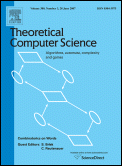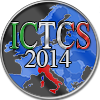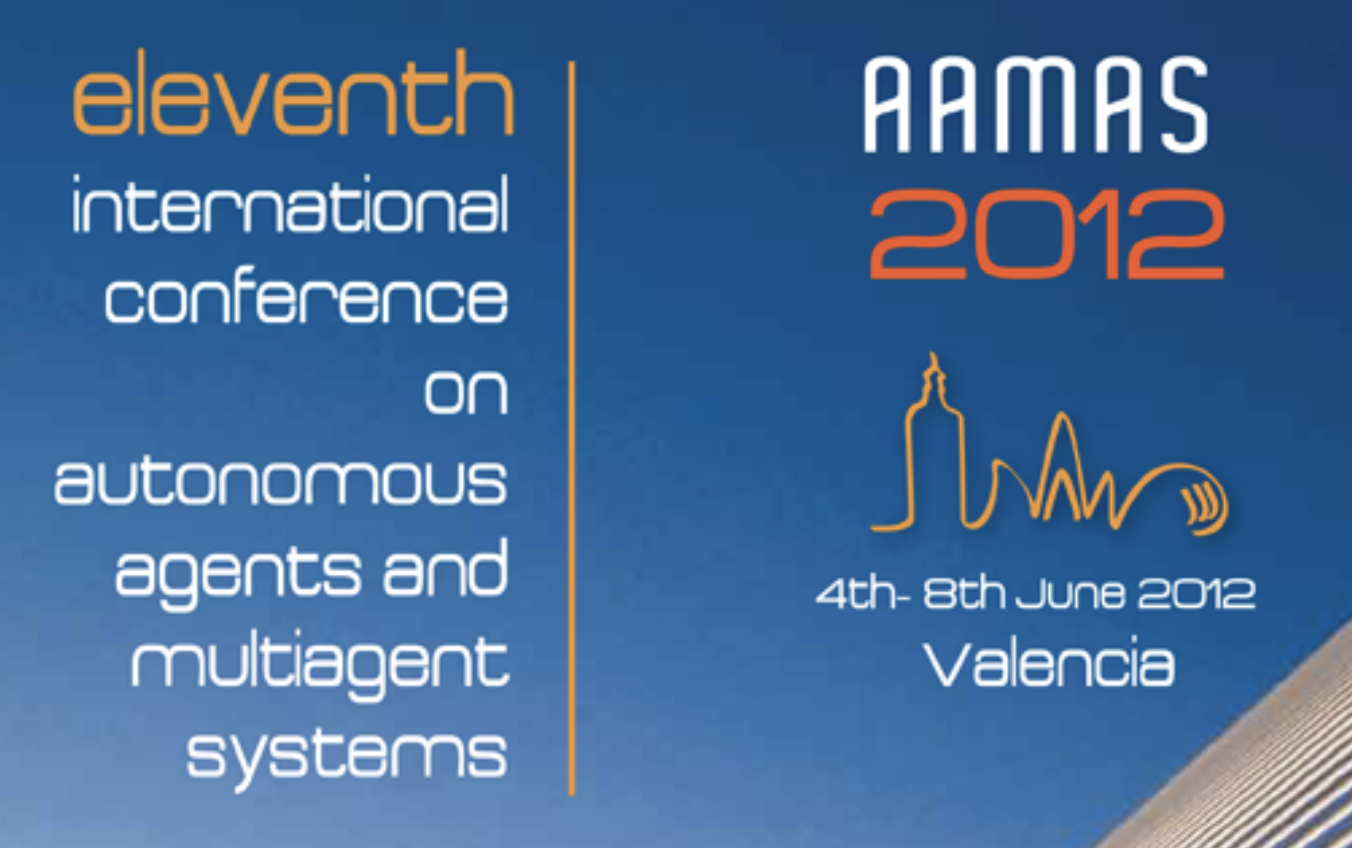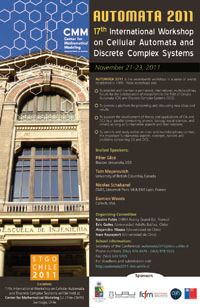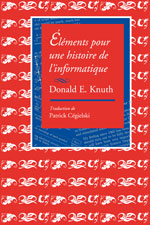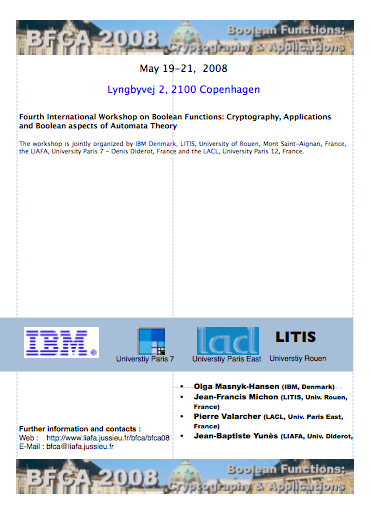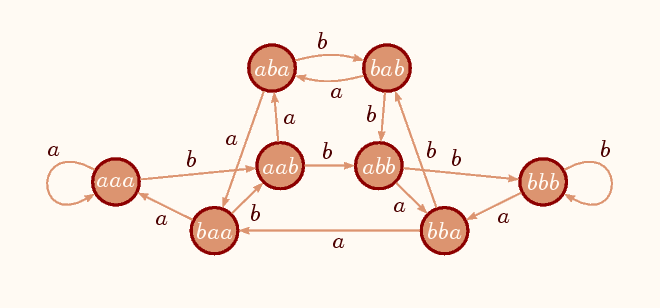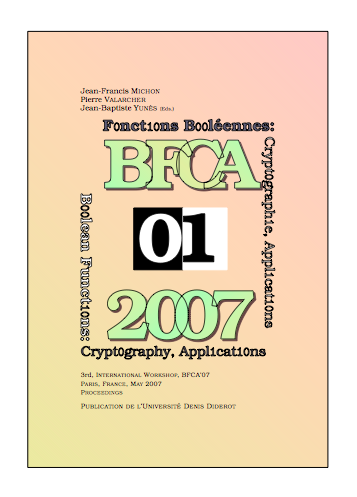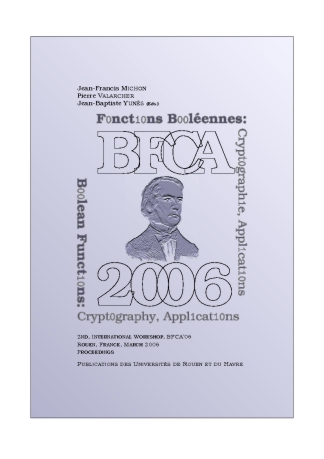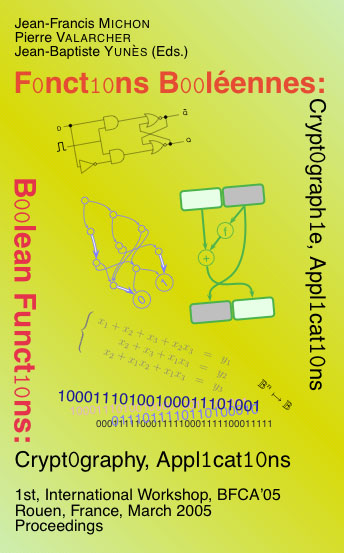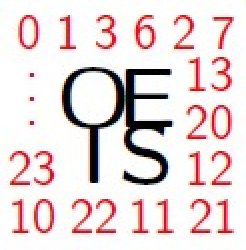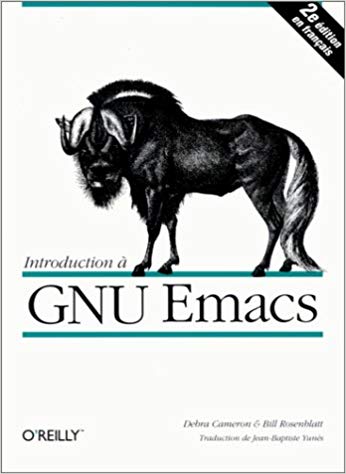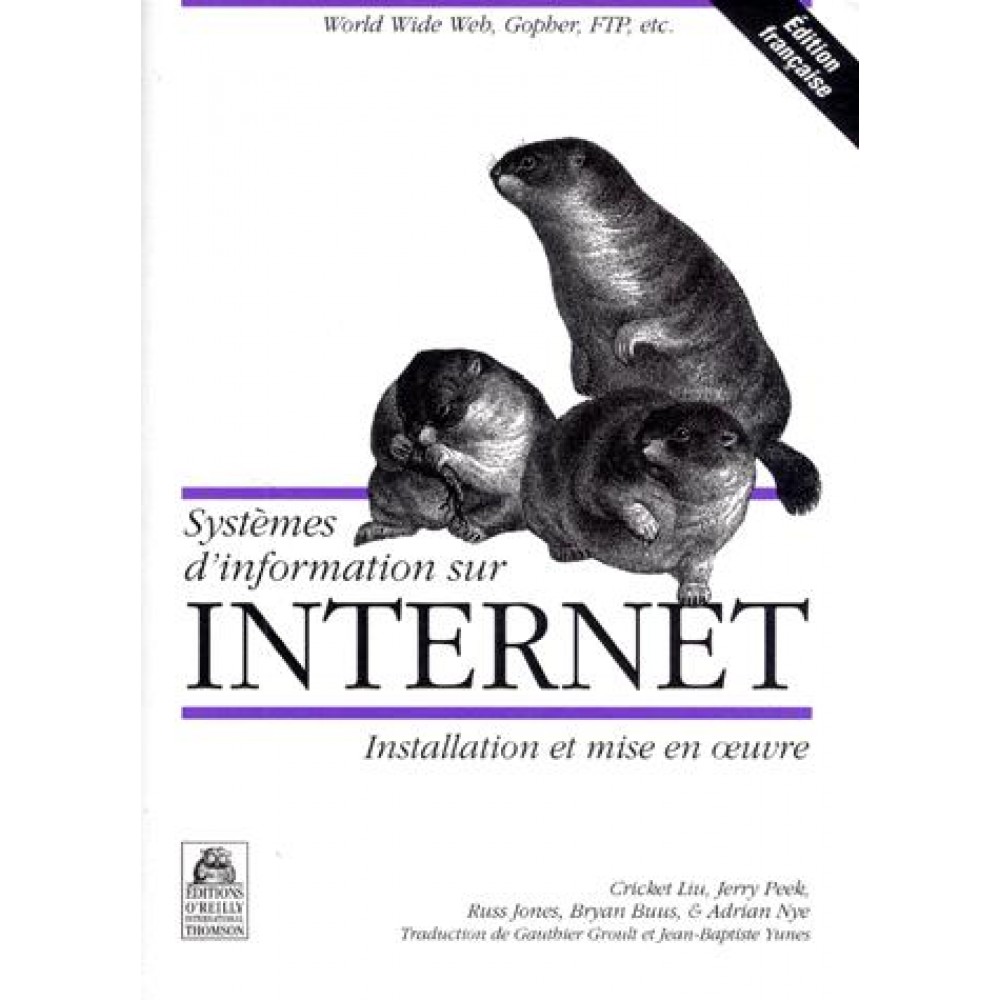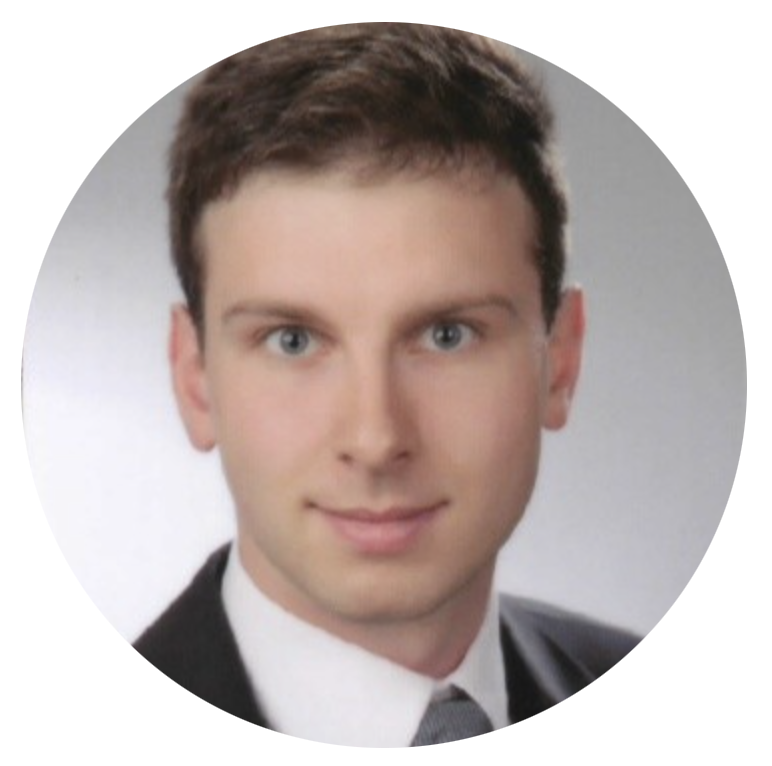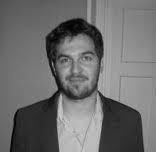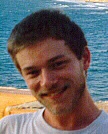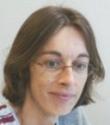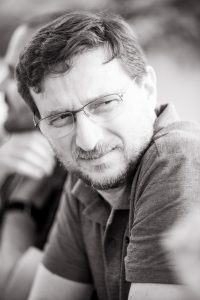
Mes activités de recherche donnent habituellement lieu à des publications ou communications. J’ai aussi dirigé des recherches. Je suis parfois sollicité pour être membre de jurys ou rapporteur de thèse et d’habilitation à diriger des recherche. J’organise parfois des événements. Il m’a aussi été offert d’avoir des charges particulières, comme être éditeur. D’autre part, je participe et monte des projets. Il reste toutefois certaines tâches ou activités qui sont inclassables.
Publications
73 Entrées « ‹ 1 de 2
› » 2024
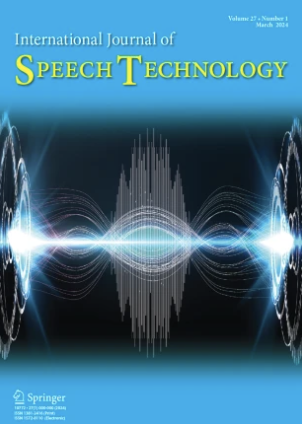
Nicolas Ballier, Taylor Arnold, Adrien Méli, Tori Thurston, Jean-Baptiste Yunès
Whisper for L2 speech scoring Article de journal
Dans: Int J Speech Technol, p. 923—934, 2024.
@article{Ballier2024,
title = {Whisper for L2 speech scoring},
author = {Nicolas Ballier and Taylor Arnold and Adrien Méli and Tori Thurston and Jean-Baptiste Yunès },
editor = {Springer},
doi = {10.1007/s10772-024-10141-5},
year = {2024},
date = {2024-11-01},
urldate = {2024-11-01},
journal = {Int J Speech Technol},
pages = {923—934},
abstract = {In this paper, we examine whether confidence scores produced by the C++ re-implementation of Whisper (Radford et al., in: International conference on machine learning, 2023) can be used to score L2 learners of English and classify them. We test whether the language prediction and its probability can be used to classify French learners of English using a specifically collected dataset for read speech and a graded corpus, the ANGLISH corpus (Tortel and Hirst, in: Proceedings of speech prosody 2010, 2010. https://doi.org/10.21437/SpeechProsody.2010-49). We show that probability scores associated with the Whisper subtokens can be used to classify learners into levels using the knn algorithm. We show the limitations of the language detection probability beyond an initial threshold where the native language L1 of the learner can actually be predicted by the speaker. We have also used the ISLE corpus (Menzel et al., in: Proceedings of LREC 2000: Language resources and evaluation conference, European Language Resources Association, 2000) to test the prediction of the levels of Italian and German learners of English (Atwell et al., in: ICAME Jurnal, 27:5–18, 2003). We show how language detection for Whisper’s multilingual larger models can be used to detect less advanced learners’ first language but cannot be used for learner level classification with advanced learners. Using a greedy alignment algorithm, we also discuss the confidence score assigned to Whisper output subtokens and how this may be used for speaker scoring, prediction of learner levels, and learner feedback. We show that low confidence scores and alternative transcriptions can be used as potential cues for learner pronunciation errors.},
keywords = {},
pubstate = {published},
tppubtype = {article}
}
In this paper, we examine whether confidence scores produced by the C++ re-implementation of Whisper (Radford et al., in: International conference on machine learning, 2023) can be used to score L2 learners of English and classify them. We test whether the language prediction and its probability can be used to classify French learners of English using a specifically collected dataset for read speech and a graded corpus, the ANGLISH corpus (Tortel and Hirst, in: Proceedings of speech prosody 2010, 2010. https://doi.org/10.21437/SpeechProsody.2010-49). We show that probability scores associated with the Whisper subtokens can be used to classify learners into levels using the knn algorithm. We show the limitations of the language detection probability beyond an initial threshold where the native language L1 of the learner can actually be predicted by the speaker. We have also used the ISLE corpus (Menzel et al., in: Proceedings of LREC 2000: Language resources and evaluation conference, European Language Resources Association, 2000) to test the prediction of the levels of Italian and German learners of English (Atwell et al., in: ICAME Jurnal, 27:5–18, 2003). We show how language detection for Whisper’s multilingual larger models can be used to detect less advanced learners’ first language but cannot be used for learner level classification with advanced learners. Using a greedy alignment algorithm, we also discuss the confidence score assigned to Whisper output subtokens and how this may be used for speaker scoring, prediction of learner levels, and learner feedback. We show that low confidence scores and alternative transcriptions can be used as potential cues for learner pronunciation errors.
Lichao Zhu, Maria Zimina-Poirot, Behnoosh Namdarzadeh, Nicolas Ballier, Jean-Baptiste Yunès
Enhancing Translation Quality: A Comparative Study of Fine-Tuning and Prompt Engineering in Dialog-Oriented Machine Translation Systems. Insights from the MULTITAN-GML Team Proceedings Article
Dans: Ninth Conference on Machine Translation, WMT'24, 2024.
@inproceedings{nokey,
title = {Enhancing Translation Quality: A Comparative Study of Fine-Tuning and Prompt Engineering in Dialog-Oriented Machine Translation Systems. Insights from the MULTITAN-GML Team},
author = {Lichao Zhu and Maria Zimina-Poirot and Behnoosh Namdarzadeh and Nicolas Ballier and Jean-Baptiste Yunès},
year = {2024},
date = {2024-11-01},
urldate = {2024-11-01},
booktitle = {Ninth Conference on Machine Translation, WMT'24},
keywords = {},
pubstate = {published},
tppubtype = {inproceedings}
}
N. Ballier, L. Burin, B. Namdarzadeh, S Ng, R. Wright, J.-B. Yunès
Probing Whisper Predictions for French, English and Persian Transcriptions Conférence
ACL Anthology, 2024.
@conference{ballier:2024,
title = {Probing Whisper Predictions for French, English and Persian Transcriptions},
author = {N. Ballier and L. Burin and B. Namdarzadeh and S Ng and R. Wright and J.-B. Yunès},
editor = {7th International Conference on Natural Language and Speech Processing, October 19-20, 2024, Trento, Italy},
year = {2024},
date = {2024-10-19},
urldate = {2024-10-19},
booktitle = {ACL Anthology},
keywords = {},
pubstate = {published},
tppubtype = {conference}
}
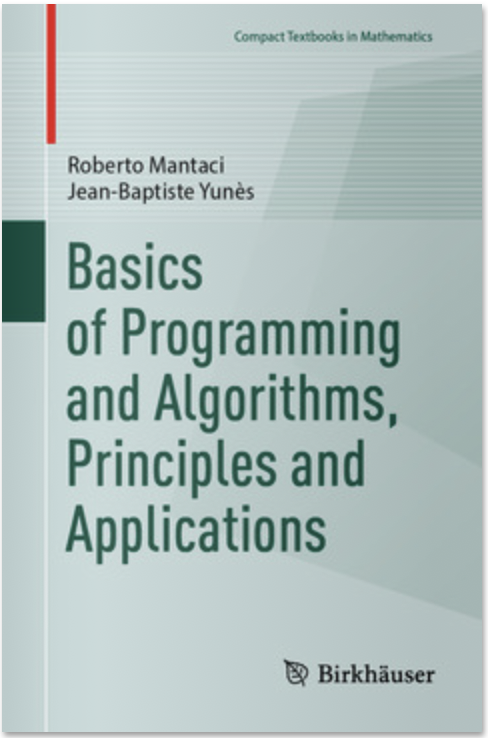
Roberto Mantaci, Jean-Baptiste Yunès
Basics of Programming and Algorithms, Principles and Applications Ouvrage
Birkhaüser Verlag, 2024, ISBN: 978-3-031-59800-5.
@book{Mantaci2024,
title = {Basics of Programming and Algorithms, Principles and Applications},
author = {Roberto Mantaci and Jean-Baptiste Yunès},
isbn = {978-3-031-59800-5},
year = {2024},
date = {2024-07-01},
urldate = {2024-07-01},
publisher = {Birkhaüser Verlag},
series = {Compact Textbooks in Mathematics Serie},
abstract = {This textbook offers an introduction to topics in algorithms and programming with python. It is originally intended for mathematical students not sufficiently aware about these computer science fields seeking a deeper understanding. It addresses fundamental questions on how to analyze the performance of an algorithm and equips readers with the skills to implement them using python.
The textbook is organized in two parts. Part I introduces Python Programming offering a solid foundation to python essentials. Topics covered include first steps in python programming, programs, functions and recursion, data structures. Part II shifts focus to Algorithms and covers topics such as algorithm performance, recursion, the sorting problem, trees as data structures, etc.
This book has its origins from several different courses given in the context of thematic schools to diverse audiences in different countries over the years. These countries include Cambodia, Kenya, and Madagascar.},
keywords = {},
pubstate = {published},
tppubtype = {book}
}
This textbook offers an introduction to topics in algorithms and programming with python. It is originally intended for mathematical students not sufficiently aware about these computer science fields seeking a deeper understanding. It addresses fundamental questions on how to analyze the performance of an algorithm and equips readers with the skills to implement them using python.
The textbook is organized in two parts. Part I introduces Python Programming offering a solid foundation to python essentials. Topics covered include first steps in python programming, programs, functions and recursion, data structures. Part II shifts focus to Algorithms and covers topics such as algorithm performance, recursion, the sorting problem, trees as data structures, etc.
This book has its origins from several different courses given in the context of thematic schools to diverse audiences in different countries over the years. These countries include Cambodia, Kenya, and Madagascar.
2023
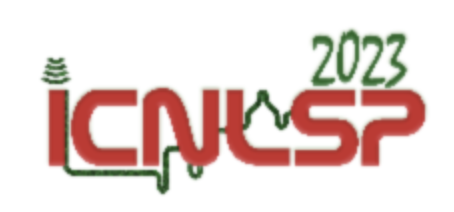
Nicolas Ballier, Behnoosh Namdarzadeh, Maria Zimina, Jean-Baptiste Yunès
Translating Dislocations or Parentheticals: Investigating the Role of Prosodic Boundaries for Spoken Language Translation from French into English Conférence
6th International Conference on Natural Language and Speech Processing (ICNLSP 2023), Mourad Abbas, Abed Alhakim Freihat, Dec 2023, Trento (Italy), Italy, 2023.
@conference{ballier:2023-xx,
title = {Translating Dislocations or Parentheticals: Investigating the Role of Prosodic Boundaries for Spoken Language Translation from French into English},
author = {Nicolas Ballier and Behnoosh Namdarzadeh and Maria Zimina and Jean-Baptiste Yunès},
year = {2023},
date = {2023-12-01},
urldate = {2023-12-01},
booktitle = {6th International Conference on Natural Language and Speech Processing (ICNLSP 2023), Mourad Abbas, Abed Alhakim Freihat, Dec 2023, Trento (Italy), Italy},
abstract = {This paper examines some of the effects of prosodic boundaries on ASR outputs and Spoken Language Translations into English for two competing French structures ("c'est" dislocation vs. "c'est" parentheticals). One native speaker of French read 104 test sentences that were then submitted to two systems. We compared the outputs of two toolkits, SYSTRAN Pure Neural Server (SPNS9) (Crego et al., 2016) and Whisper. For SPNS9, we compared the translation of the text file used for the reading with the translation of the transcription generated through Vocapia ASR. We also tested the transcription engine for speech recognition uploading an MP3 file and used the same procedure for AI Whisper's Web-scale Supervised Pretraining for Speech Recognition system (Radford et al., 2022). We reported WER for the transcription tasks and the BLEU scores for the different models. We evidenced the variability of the punctuation in the ASR outputs and discussed it in relation to the duration of the utterance. We discussed the effects of the prosodic boundaries. We described the status of the boundary in the speech-to-text systems, discussing the consequence for the neural machine translation of the rendering of the prosodic boundary by a comma, a full stop, or any other punctuation symbol. We used the reference transcript of the reading phase to compute the edit distance between the reference transcript and the ASR output. We also used textometric analyses with iTrameur (Fleury and Zimina, 2014) for insights into the errors that can be attributed to ASR or to Neural Machine translation.},
keywords = {},
pubstate = {published},
tppubtype = {conference}
}
This paper examines some of the effects of prosodic boundaries on ASR outputs and Spoken Language Translations into English for two competing French structures ("c'est" dislocation vs. "c'est" parentheticals). One native speaker of French read 104 test sentences that were then submitted to two systems. We compared the outputs of two toolkits, SYSTRAN Pure Neural Server (SPNS9) (Crego et al., 2016) and Whisper. For SPNS9, we compared the translation of the text file used for the reading with the translation of the transcription generated through Vocapia ASR. We also tested the transcription engine for speech recognition uploading an MP3 file and used the same procedure for AI Whisper's Web-scale Supervised Pretraining for Speech Recognition system (Radford et al., 2022). We reported WER for the transcription tasks and the BLEU scores for the different models. We evidenced the variability of the punctuation in the ASR outputs and discussed it in relation to the duration of the utterance. We discussed the effects of the prosodic boundaries. We described the status of the boundary in the speech-to-text systems, discussing the consequence for the neural machine translation of the rendering of the prosodic boundary by a comma, a full stop, or any other punctuation symbol. We used the reference transcript of the reading phase to compute the edit distance between the reference transcript and the ASR output. We also used textometric analyses with iTrameur (Fleury and Zimina, 2014) for insights into the errors that can be attributed to ASR or to Neural Machine translation.

Fabien Lopez, Gabriela González, Damien Hansen, Mariam Nakhlé, Behnoosh Namdarzadeh, Nicolas Ballier, Marco Dinarelli, Emmanuelle Esperança-Rodier, Sui He, Sadaf Mohseni, Caroline Rossi, Didier Schwab, Jun Yang, Jean-Baptiste Yunès, Lichao Zhu
The MAKE-NMTViz System Description for the WMT23 Literary Task Actes
2023.
@proceedings{Lopez2023,
title = {The MAKE-NMTViz System Description for the WMT23 Literary Task},
author = {Fabien Lopez and Gabriela González and Damien Hansen and Mariam Nakhlé and Behnoosh Namdarzadeh and Nicolas Ballier and Marco Dinarelli and Emmanuelle Esperança-Rodier and Sui He and Sadaf Mohseni and Caroline Rossi and Didier Schwab and Jun Yang and Jean-Baptiste Yunès and Lichao Zhu
},
year = {2023},
date = {2023-01-01},
urldate = {2023-01-01},
abstract = {This paper describes the MAKE-NMT-Viz's submission to the WMT 2023 Literary task. As a primary submission, we fine-tune the mBART50 model using Train, Valid1, and Test1 as part of the GuoFeng corpus (Wang et al., 2023b).We followed similar training parameters to (Lee et al., 2022) when fine-tuning mBART50. For our contrastive1 submission, we used a context-aware NMT system based on the concatenation method (Lupo et al., 2022). The training was performed in two steps: (i) a traditional sentence-level transformer (Vaswani et al., 2017) was trained for 10 epochs using GeneralData, Test2, and Valid2; (ii) second, we fine-tuned such Transformer using documentlevel data, with 3-sentence concatenation as context, for 4 epochs using Train, Test1, and Valid1 data. We then compared the three translation outputs from an interdisciplinary perspective, investigating some of the effects of sentence-vs. document-based training. Computer scientists, translators and corpus linguists discussed the remaining linguistic issues for this discourse-level literary translation.},
keywords = {},
pubstate = {published},
tppubtype = {proceedings}
}
This paper describes the MAKE-NMT-Viz's submission to the WMT 2023 Literary task. As a primary submission, we fine-tune the mBART50 model using Train, Valid1, and Test1 as part of the GuoFeng corpus (Wang et al., 2023b).We followed similar training parameters to (Lee et al., 2022) when fine-tuning mBART50. For our contrastive1 submission, we used a context-aware NMT system based on the concatenation method (Lupo et al., 2022). The training was performed in two steps: (i) a traditional sentence-level transformer (Vaswani et al., 2017) was trained for 10 epochs using GeneralData, Test2, and Valid2; (ii) second, we fine-tuned such Transformer using documentlevel data, with 3-sentence concatenation as context, for 4 epochs using Train, Test1, and Valid1 data. We then compared the three translation outputs from an interdisciplinary perspective, investigating some of the effects of sentence-vs. document-based training. Computer scientists, translators and corpus linguists discussed the remaining linguistic issues for this discourse-level literary translation.

Nicolas Ballier, Adrien Méli, Maelle Amand, Jean-Baptiste Yunès
Using Whisper LLM for Automatic Phonetic Diagnosis of L2 Speech, a Case Study with French Learners of English Proceedings Article
Dans: Mourad Abbas, Abed Alhakim Freihat (Ed.): Proceedings of the 6th International Conference on Natural Language and Speech Processing (ICNLSP 2023), Virtual Event, 16-17 December 2023, p. 282–292, Association for Computational Linguistics, 2023.
@inproceedings{Ballier2023,
title = {Using Whisper LLM for Automatic Phonetic Diagnosis of L2 Speech, a Case Study with French Learners of English},
author = {Nicolas Ballier and Adrien Méli and Maelle Amand and Jean-Baptiste Yunès
},
editor = {Mourad Abbas and Abed Alhakim Freihat},
url = {https://dblp.org/rec/conf/icnlsp/BallierMAY23.bib},
year = {2023},
date = {2023-01-01},
urldate = {2023-01-01},
booktitle = {Proceedings of the 6th International Conference on Natural Language and Speech Processing (ICNLSP 2023), Virtual Event, 16-17 December 2023},
journal = {Proceedings of the 6th International Conference on Natural Language and Speech Processing {(ICNLSP} 2023), Virtual Event, 16-17 December 2023},
pages = {282--292},
publisher = {Association for Computational Linguistics},
keywords = {},
pubstate = {published},
tppubtype = {inproceedings}
}

Lichao Zhu, Maria Zimina, Maud Bénard, Behnoosh Namdar, Nicolas Ballier, Guillaume Wisniewski, Jean-Baptiste Yunès
Investigating Techniques for a Deeper Understanding of Neural Machine Translation (NMT) Systems through Data Filtering and Fine-tuning Strategies Proceedings Article
Dans: Philipp Koehn, Barry Haddon, Tom Kocmi, Christof Monz (Ed.): Proceedings of the Eighth Conference on Machine Translation, WMT 2023, Singapore, December 6-7, 2023, p. 275–281, 2023.
@inproceedings{nokey,
title = {Investigating Techniques for a Deeper Understanding of Neural Machine Translation (NMT) Systems through Data Filtering and Fine-tuning Strategies},
author = {Lichao Zhu and Maria Zimina and Maud Bénard and Behnoosh Namdar and Nicolas Ballier and Guillaume Wisniewski and Jean-Baptiste Yunès},
editor = {Philipp Koehn and Barry Haddon and Tom Kocmi and Christof Monz},
url = {https://aclanthology.org/2023.wmt-1.28},
year = {2023},
date = {2023-01-01},
urldate = {2023-01-01},
booktitle = {Proceedings of the Eighth Conference on Machine Translation, WMT 2023, Singapore, December 6-7, 2023},
pages = {275--281},
keywords = {},
pubstate = {published},
tppubtype = {inproceedings}
}
2022
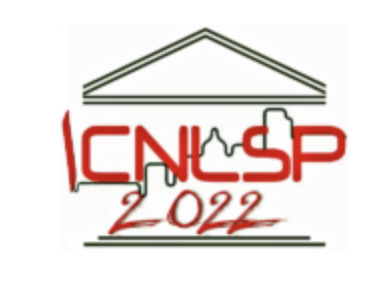
Behnoosh Namdarzadeh, Nicolas Ballier and, Guillaume Wisniewski, Lichao Zhu, Jean-Baptiste Yunès
Toward a Test Set of Dislocations in Persian for Neural Machine Translation Proceedings Article
Dans: The Third International Workshop on NLP Solutions for Under Resourced Languages (NSURL 2022), 2022.
@inproceedings{Namdarzadeh2022,
title = {Toward a Test Set of Dislocations in Persian for Neural Machine Translation},
author = {Behnoosh Namdarzadeh and Nicolas Ballier and, Guillaume Wisniewski and Lichao Zhu and Jean-Baptiste Yunès},
year = {2022},
date = {2022-12-18},
urldate = {2022-12-18},
booktitle = {The Third International Workshop on NLP Solutions for Under Resourced Languages (NSURL 2022)},
abstract = {This paper describes a test set designed to analyse the translation of dislocations from Persian, to be used for testing neural machine translation models. We first tested the accuracy of the two Universal dependency treebanks for Persian to automatically detect dislocations. Then we parsed the available Persian treebanks on GREW (Bonfante et al., 2018) to build a specific test set containing examples of dislocations. With available aligned data on OPUS (Tiedemann, 2016), we trained a model to translate from Persian into English on openNMT (Klein et al., 2017). We report the results of our translation test set by several toolkits (Google Translate, MBART-50 (Tang et al., 2020), Microsoft Bing and our in-house translation model) for the translation into English. We discuss why dislocations in Persian provide an interesting testbed for neural machine translation.},
keywords = {},
pubstate = {published},
tppubtype = {inproceedings}
}
This paper describes a test set designed to analyse the translation of dislocations from Persian, to be used for testing neural machine translation models. We first tested the accuracy of the two Universal dependency treebanks for Persian to automatically detect dislocations. Then we parsed the available Persian treebanks on GREW (Bonfante et al., 2018) to build a specific test set containing examples of dislocations. With available aligned data on OPUS (Tiedemann, 2016), we trained a model to translate from Persian into English on openNMT (Klein et al., 2017). We report the results of our translation test set by several toolkits (Google Translate, MBART-50 (Tang et al., 2020), Microsoft Bing and our in-house translation model) for the translation into English. We discuss why dislocations in Persian provide an interesting testbed for neural machine translation.
Guillaume Wisniewski, Lichao Zhu, Jean-Baptiste Yunès, Nicolas Ballier
La robustesse de la traduction neuronale : les systèmes de traduction automatique neuronale à l'épreuve de la reproductibilité de l'expérience Proceedings Article
Dans: Journée d'étude '"Robustesse des systèmes de TAL", Paris, France, 2022.
@inproceedings{Wisniewski2022,
title = {La robustesse de la traduction neuronale : les systèmes de traduction automatique neuronale à l'épreuve de la reproductibilité de l'expérience},
author = {Guillaume Wisniewski and Lichao Zhu and Jean-Baptiste Yunès and Nicolas Ballier},
url = {https://hal.science/hal-03912352/file/main.pdf},
year = {2022},
date = {2022-11-01},
urldate = {2022-11-01},
booktitle = {Journée d'étude '"Robustesse des systèmes de TAL"},
address = {Paris, France},
keywords = {},
pubstate = {published},
tppubtype = {inproceedings}
}
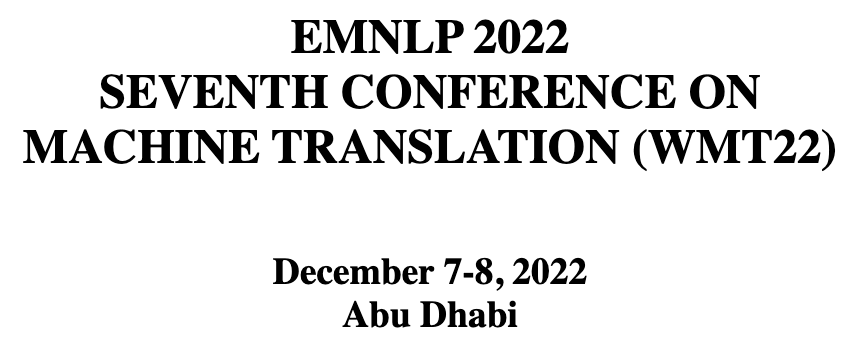
Nicolas Ballier,
Jean-Baptiste Yunès,
Guillaume Wisniewski,
Lichao Zhu,
Maria Zimina-Poirot
The SPECTRANS System Description for the WMT22 Biomedical Task Proceedings Article
Dans: Proceedings of the Seventh Conference on Machine Translation, {WMT}
2022, Abu Dhabi, United Arab Emirates (Hybrid), December 7-8, 2022, p. 895–900, Association for Computational Linguistics, 2022.
@inproceedings{Ballier2022,
title = {The SPECTRANS System Description for the WMT22 Biomedical Task},
author = {Nicolas Ballier,
Jean-Baptiste Yunès,
Guillaume Wisniewski,
Lichao Zhu,
Maria Zimina-Poirot},
url = {https://aclanthology.org/2022.wmt-1.82
https://aclanthology.org/2022.wmt-1.82.pdf},
year = {2022},
date = {2022-01-01},
urldate = {2022-01-01},
booktitle = {Proceedings of the Seventh Conference on Machine Translation, {WMT}
2022, Abu Dhabi, United Arab Emirates (Hybrid), December 7-8, 2022},
pages = {895--900},
publisher = {Association for Computational Linguistics},
abstract = {This paper describes the SPECTRANS submission for the WMT 2022 biomedical shared task. We present the results of our experiments using the training corpora and the JoeyNMT (Kreutzer et al., 2019) and SYSTRAN Pure Neural Server/ Advanced Model Studio toolkits for the language directions English to French and French to English. We compare the pre- dictions of the different toolkits. We also use JoeyNMT to fine-tune the model with a selection of texts from WMT, Khresmoi and UFAL data sets. We report our results and assess the respective merits of the different translated texts.},
keywords = {},
pubstate = {published},
tppubtype = {inproceedings}
}
This paper describes the SPECTRANS submission for the WMT 2022 biomedical shared task. We present the results of our experiments using the training corpora and the JoeyNMT (Kreutzer et al., 2019) and SYSTRAN Pure Neural Server/ Advanced Model Studio toolkits for the language directions English to French and French to English. We compare the pre- dictions of the different toolkits. We also use JoeyNMT to fine-tune the model with a selection of texts from WMT, Khresmoi and UFAL data sets. We report our results and assess the respective merits of the different translated texts.
2021
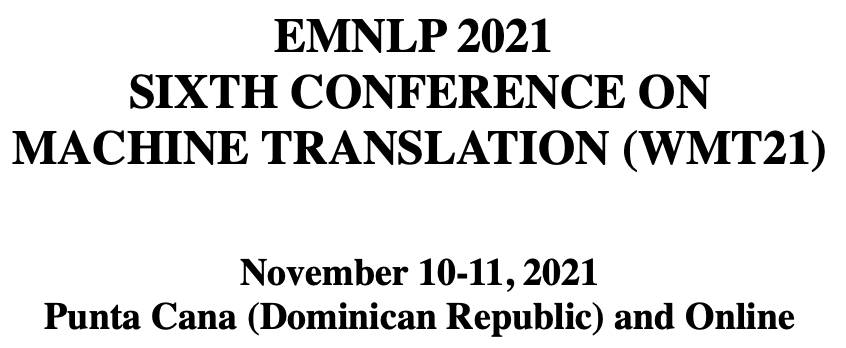
N. Ballier, D. Cho, B. Faye, Z-Y. Ke, H. Martikainen, M. Pecman M., G. Wisniewski, J-B. Yunès, L. Zhu, M. Zimina-Poirot
The SPECTRANS System Description for the WMT21 Terminology Task Proceedings Article
Dans: Proceedings of the Sixth Conference on Machine Translation (WMT), p. 818-825, Association for Computational Linguistics 2021.
@inproceedings{Ballier2021,
title = {The SPECTRANS System Description for the WMT21 Terminology Task},
author = {N. Ballier and D. Cho and B. Faye and Z-Y. Ke and H. Martikainen and M. Pecman M. and G. Wisniewski and J-B. Yunès and L. Zhu and M. Zimina-Poirot},
url = {http://www.statmt.org/wmt21/pdf/2021.wmt-1.80.pdf},
year = {2021},
date = {2021-11-11},
urldate = {2021-11-11},
booktitle = {Proceedings of the Sixth Conference on Machine Translation (WMT)},
pages = {818-825},
organization = {Association for Computational Linguistics},
abstract = {This paper discusses the WMT 2021 terminology shared task from a "meta" perspective. We present the results of our experiments using the terminology dataset and the OpenNMT (Klein et al., 2017) and JoeyNMT (Kreutzer et al., 2019) toolkits for the language direction English to French. Our experiment 1 compares the predictions of the two toolkits. Experiment 2 uses OpenNMT to fine-tune the model. We report our results for the task with the evaluation script but mostly discuss the linguistic properties of the terminology dataset provided for the task. We provide evidence of the importance of text genres across scores, having replicated the evaluation scripts.},
keywords = {},
pubstate = {published},
tppubtype = {inproceedings}
}
This paper discusses the WMT 2021 terminology shared task from a "meta" perspective. We present the results of our experiments using the terminology dataset and the OpenNMT (Klein et al., 2017) and JoeyNMT (Kreutzer et al., 2019) toolkits for the language direction English to French. Our experiment 1 compares the predictions of the two toolkits. Experiment 2 uses OpenNMT to fine-tune the model. We report our results for the task with the evaluation script but mostly discuss the linguistic properties of the terminology dataset provided for the task. We provide evidence of the importance of text genres across scores, having replicated the evaluation scripts.
2020
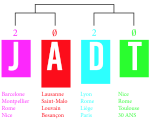
Maria Zimina, Nicolas Ballier, Jean-Baptiste Yunès
Approche textométrique des phases d'entraînement en traduction automatique neuronale (TAN) : étude de cas avec Europarl et OpenNMT Proceedings Article
Dans: JADT 2020 15èmes Journées Internationales d'Analyse statistique des Données Textuelles, Toulouse, France, Jun. 16-19., 2020.
@inproceedings{jadt2020,
title = {Approche textométrique des phases d'entraînement en traduction automatique neuronale (TAN) : étude de cas avec Europarl et OpenNMT},
author = {Maria Zimina and Nicolas Ballier and Jean-Baptiste Yunès},
url = {https://jadt2020.sciencesconf.org/},
year = {2020},
date = {2020-06-16},
booktitle = {JADT 2020 15èmes Journées Internationales d'Analyse statistique des Données Textuelles, Toulouse, France, Jun. 16-19.},
school = {JADT 2020 15èmes Journées Internationales d'Analyse statistique des Données Textuelles, Toulouse, France, Jun. 16-19.},
howpublished = {Accepted},
keywords = {},
pubstate = {published},
tppubtype = {inproceedings}
}
Nicolas Ballier
Jean-Baptiste Yunès
RELIA, un projet interdisciplinaire d'initiation à la recherche par le TAL Proceedings Article
Dans: JEP - TALN - RECITAL 2020.
@inproceedings{Yunès2020,
title = {RELIA, un projet interdisciplinaire d'initiation à la recherche par le TAL},
author = {Nicolas Ballier
Jean-Baptiste Yunès},
url = {https://jep-taln2020.loria.fr
https://yunes.informatique.univ-paris-diderot.fr/accueil/enseignement/ireel-relia
https://videos.univ-lorraine.fr/index.php?act=view&id=9739
},
year = {2020},
date = {2020-06-08},
organization = {JEP - TALN - RECITAL},
howpublished = {online due to COVID pandemic},
keywords = {},
pubstate = {published},
tppubtype = {inproceedings}
}
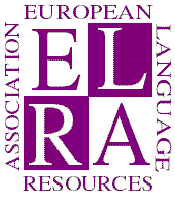
Nicolas Ballier, Nabil Amari, Laure Mérat, Jean-Baptiste Yunès
The learnability of the annotated input in NMT (Replicating Vanmassenhove et al. 2018 with OpenNMT) Proceedings Article
Dans: European Language Resources Association (Ed.): Proceedings of the 12th Language Resources and Evaluation Conference, p. 5631–5640, 2020.
@inproceedings{reprolang2020,
title = {The learnability of the annotated input in NMT (Replicating Vanmassenhove et al. 2018 with OpenNMT)},
author = {Nicolas Ballier and Nabil Amari and Laure Mérat and Jean-Baptiste Yunès},
editor = {European Language Resources Association},
url = {https://www.clarin.eu/event/2020/reprolang-2020},
year = {2020},
date = {2020-05-01},
booktitle = {Proceedings of the 12th Language Resources and Evaluation Conference},
pages = {5631–5640},
school = {REPROLANG 2020 — LREC 2020, Marseille, France, May 13-15},
abstract = {In this paper, we reproduce some of the experiments related to neural network training for Machine Translation as reported in (Vanmassenhove and Way, 2018). They annotated a sample from the EN-FR and EN-DE Europarl aligned corpora with syntactic and semantic annotations to train neural networks with the Nematus Neural Machine Translation (NMT) toolkit. Following the original publication, we obtained lower BLEU scores than the authors of the original paper, but on a more limited set of annotations. In the second half of the paper, we try to analyze the difference in the results obtained and suggest some methods to improve the results. We discuss the Byte Pair Encoding (BPE) used in the pre-processing phase and suggest feature ablation in relation to the granularity of syntactic and semantic annotations. The learnability of the annotated input is discussed in relation to existing resources for the target languages. We also discuss the feature representation likely to have been adopted for combining features.},
howpublished = {Accepted},
keywords = {},
pubstate = {published},
tppubtype = {inproceedings}
}
In this paper, we reproduce some of the experiments related to neural network training for Machine Translation as reported in (Vanmassenhove and Way, 2018). They annotated a sample from the EN-FR and EN-DE Europarl aligned corpora with syntactic and semantic annotations to train neural networks with the Nematus Neural Machine Translation (NMT) toolkit. Following the original publication, we obtained lower BLEU scores than the authors of the original paper, but on a more limited set of annotations. In the second half of the paper, we try to analyze the difference in the results obtained and suggest some methods to improve the results. We discuss the Byte Pair Encoding (BPE) used in the pre-processing phase and suggest feature ablation in relation to the granularity of syntactic and semantic annotations. The learnability of the annotated input is discussed in relation to existing resources for the target languages. We also discuss the feature representation likely to have been adopted for combining features.
2018

Luidnel Maignan, Jean-Baptiste Yunès
Generalized FSSP on Two Triangular Tilings Proceedings Article
Dans: 2018 Sixth International Symposium on Computing and Networking Workshops (CANDARW), Hida Takayama, Japan, November 27-30, 2018, p. 27–31, IEEE 2018.
@inproceedings{maignan2018generalized,
title = {Generalized FSSP on Two Triangular Tilings},
author = {Luidnel Maignan and Jean-Baptiste Yunès},
url = {https://ieeexplore.ieee.org/document/8590867
https://is-candar.org/candar18/},
doi = {10.1109/CANDARW.2018.00013},
year = {2018},
date = {2018-11-27},
booktitle = {2018 Sixth International Symposium on Computing and Networking Workshops (CANDARW), Hida Takayama, Japan, November 27-30, 2018},
pages = {27--31},
organization = {IEEE},
abstract = {Maignan and Yunes have already investigated solutions to the generalized firing squad synchronization problem for square tilings with both Moore and Von Neumann neighborhoods, and then shown that the same concepts could be used to handle hexagonal tilings. The communication grids for these cellular space are all very regular in a precise formal sense: they are Cayley graphs. In this paper we investigate the triangular tiling because it is very related to the hexagonal one but is not a Cayley graph. We also consider another tiling of triangles obtained by dividing every square of a square tiling into four triangles. We show that the same concepts still apply, therefore showing that the previous solutions can be extended to a broader class of spaces included in what we may call Cayley Graphs on Groupoïd.},
keywords = {},
pubstate = {published},
tppubtype = {inproceedings}
}
Maignan and Yunes have already investigated solutions to the generalized firing squad synchronization problem for square tilings with both Moore and Von Neumann neighborhoods, and then shown that the same concepts could be used to handle hexagonal tilings. The communication grids for these cellular space are all very regular in a precise formal sense: they are Cayley graphs. In this paper we investigate the triangular tiling because it is very related to the hexagonal one but is not a Cayley graph. We also consider another tiling of triangles obtained by dividing every square of a square tiling into four triangles. We show that the same concepts still apply, therefore showing that the previous solutions can be extended to a broader class of spaces included in what we may call Cayley Graphs on Groupoïd.

Yoann Marquer, Luidnel Maignan, Jean-Baptiste Yunès
Proving Formally a Field-Based FSSP Solution Rapport technique
2018.
@techreport{marquer2018proving,
title = {Proving Formally a Field-Based FSSP Solution},
author = {Yoann Marquer and Luidnel Maignan and Jean-Baptiste Yunès},
url = {https://hal.archives-ouvertes.fr/hal-01739317},
year = {2018},
date = {2018-09-11},
abstract = {In the research domain of cellular automata algorithmics, the firing squad synchronization problem is a famous problem that has been solved in many ways. However, very few of these solutions have a detailed formal proof suitable for proof assistant and for human understanding. The reason is that the correctness of those solutions is more easily seen from a high level point of view and from the way the solution has been constructed than from the actual formal description of the constructed solution. The field-based approach consists in giving a formal description of a new high-level and modular description and the reduction process down to the final low-level solution. The decomposition in modules are natural from a design point of view and is a precise counterpart of the previous informal high-level description. This research report aims to present an understandable proof of correctness of the high-level field-based solution suitable for an implementation in Coq.},
keywords = {},
pubstate = {published},
tppubtype = {techreport}
}
In the research domain of cellular automata algorithmics, the firing squad synchronization problem is a famous problem that has been solved in many ways. However, very few of these solutions have a detailed formal proof suitable for proof assistant and for human understanding. The reason is that the correctness of those solutions is more easily seen from a high level point of view and from the way the solution has been constructed than from the actual formal description of the constructed solution. The field-based approach consists in giving a formal description of a new high-level and modular description and the reduction process down to the final low-level solution. The decomposition in modules are natural from a design point of view and is a precise counterpart of the previous informal high-level description. This research report aims to present an understandable proof of correctness of the high-level field-based solution suitable for an implementation in Coq.
2016

Luidnel Maignan, Jean-Baptiste Yunès
Synchronizing the squad with (almost) arbitrary cut ratio Proceedings Article
Dans: 2016 Fourth International Symposium on Computing and Networking (CANDAR), Hiroshima, Japan, November 22-25, 2016, p. 229–235, IEEE 2016.
@inproceedings{maignan2016synchronizing,
title = {Synchronizing the squad with (almost) arbitrary cut ratio},
author = {Luidnel Maignan and Jean-Baptiste Yunès},
url = {http://is-candar.org/afca16
},
doi = {10.1109/CANDAR.2016.0048},
year = {2016},
date = {2016-11-22},
booktitle = {2016 Fourth International Symposium on Computing and Networking (CANDAR), Hiroshima, Japan, November 22-25, 2016},
pages = {229--235},
organization = {IEEE},
abstract = {In this paper, we design a solution to the generalized firing squad problem where the splittings can be chosen to happen at any ratio greater than two thirds. This is in the same spirit as the (non-generalized) solutions of Mazoyer except that we do not use signal speeds but the concept of fields to achieve this goal. Signals and speeds do appear visually as an effect of the spatio-temporal structure of the cellular automaton. However, not being setup by design allows the solution to automatically extends to more generalized settings. Moreover, the conceptual design of the solution is separated from the state space optimization that is only handle afterward. The finiteness of state space is also sketched.},
keywords = {},
pubstate = {published},
tppubtype = {inproceedings}
}
In this paper, we design a solution to the generalized firing squad problem where the splittings can be chosen to happen at any ratio greater than two thirds. This is in the same spirit as the (non-generalized) solutions of Mazoyer except that we do not use signal speeds but the concept of fields to achieve this goal. Signals and speeds do appear visually as an effect of the spatio-temporal structure of the cellular automaton. However, not being setup by design allows the solution to automatically extends to more generalized settings. Moreover, the conceptual design of the solution is separated from the state space optimization that is only handle afterward. The finiteness of state space is also sketched.

Luidnel Maignan, Jean-Baptiste Yunès
A field based solution of Mazoyer’s FSSP schema Proceedings Article
Dans: Samira El Yacoubi, Jaroslaw Wąs, Stefania Bandini (Ed.): International Conference on Cellular Automata, ACRI 2016. Fez, Morocco, September 5-8, 2016, p. 134–143, Springer, Cham 2016, ISBN: 978-3-319-44365-2.
@inproceedings{maignan2016field,
title = {A field based solution of Mazoyer’s FSSP schema},
author = {Luidnel Maignan and Jean-Baptiste Yunès},
editor = {Samira El Yacoubi and Jaroslaw Wąs and Stefania Bandini},
doi = {10.1007/978-3-319-44365-2_13},
isbn = {978-3-319-44365-2},
year = {2016},
date = {2016-09-05},
booktitle = {International Conference on Cellular Automata, ACRI 2016. Fez, Morocco, September 5-8, 2016},
pages = {134--143},
organization = {Springer, Cham},
abstract = {Continuing our line of work on field based cellular automata programming we, here, focus our attention on an implementation of Mazoyer’s schema for cellular synchronization problem. Due to its very special nature among the numerous solutions to the problem, we emphasize the power of cellular fields to construct cellular programs: clear semantic construction, modularity, automatic synthesis of finite state machines.},
keywords = {},
pubstate = {published},
tppubtype = {inproceedings}
}
Continuing our line of work on field based cellular automata programming we, here, focus our attention on an implementation of Mazoyer’s schema for cellular synchronization problem. Due to its very special nature among the numerous solutions to the problem, we emphasize the power of cellular fields to construct cellular programs: clear semantic construction, modularity, automatic synthesis of finite state machines.
Daniel Racoceanu, David Ameisen, A Veillard, Ben B Cheikh, E Attieh, P Brezillon, Jean-Baptiste Yunès, J-M Temerson, L Toubiana, V Verger, others
Towards efficient collaborative digital pathology: a pioneer initiative of the FlexMIm project Article de journal
Dans: Diagnostic Pathology, vol. 1, no. 8, 2016, ISSN: 2364-4893.
@article{racoceanu2016towards,
title = {Towards efficient collaborative digital pathology: a pioneer initiative of the FlexMIm project},
author = {Daniel Racoceanu and David Ameisen and A Veillard and Ben B Cheikh and E Attieh and P Brezillon and Jean-Baptiste Yunès and J-M Temerson and L Toubiana and V Verger and others},
doi = {10.17629/www.diagnosticpathology.eu-2016-8:199},
issn = {2364-4893},
year = {2016},
date = {2016-06-08},
journal = {Diagnostic Pathology},
volume = {1},
number = {8},
keywords = {},
pubstate = {published},
tppubtype = {article}
}
Roberto Mantaci, Paolo Massazza, Jean-Baptiste Yunès
An efficient algorithm for generating symmetric ice piles Article de journal
Dans: Theoretical Computer Science, vol. 629, p. 96–115, 2016.
@article{mantaci2016efficient,
title = {An efficient algorithm for generating symmetric ice piles},
author = {Roberto Mantaci and Paolo Massazza and Jean-Baptiste Yunès},
doi = {10.1016/j.tcs.2015.10.024},
year = {2016},
date = {2016-05-16},
journal = {Theoretical Computer Science},
volume = {629},
pages = {96--115},
publisher = {Elsevier},
keywords = {},
pubstate = {published},
tppubtype = {article}
}
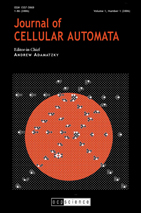
Luidnel Maignan, Jean-Baptiste Yunès
Finitization of Infinite Field-based Multi-general FSSP Solution. Article de journal
Dans: Journal of Cellular Automata, vol. 12, 2016, ISSN: 1557-5997.
@article{maignan2016finitization,
title = {Finitization of Infinite Field-based Multi-general FSSP Solution.},
author = {Luidnel Maignan and Jean-Baptiste Yunès},
url = {https://www.oldcitypublishing.com/journals/jca-home/jca-issue-contents/jca-volume-12-number-1-2-2016/jca-12-1-2-p-121-139/},
issn = {1557-5997},
year = {2016},
date = {2016-01-01},
journal = {Journal of Cellular Automata},
volume = {12},
abstract = {In a previous work we presented a general schema to solve the 1D Generalized Firing Squad Synchronization Problem. We used a semantic approach and designed it in a modular way using the concept of fields (open CA). The proposed solution is not directly a finite cellular automaton because it needs unbounded integers in distance fields, and an unbounded stack of fields due to the recursive nature of the algorithm. In this paper, we extend the solution to tackle the multi-general problem and show that this approach does effectively leads to a finite cellular automaton. For this, we exhibit a projection function from infinite to finite states and write a program that generates the associated finite transition table. We finally sketch some theoretical arguments for the validity of the construction.},
keywords = {},
pubstate = {published},
tppubtype = {article}
}
In a previous work we presented a general schema to solve the 1D Generalized Firing Squad Synchronization Problem. We used a semantic approach and designed it in a modular way using the concept of fields (open CA). The proposed solution is not directly a finite cellular automaton because it needs unbounded integers in distance fields, and an unbounded stack of fields due to the recursive nature of the algorithm. In this paper, we extend the solution to tackle the multi-general problem and show that this approach does effectively leads to a finite cellular automaton. For this, we exhibit a projection function from infinite to finite states and write a program that generates the associated finite transition table. We finally sketch some theoretical arguments for the validity of the construction.
2014

David Ameisen, Christophe Deroulers, Valérie Perrier, Fatiha Bouhidel, Maxime Battistella, Luc Legrès, Anne Janin, Philippe Bertheau, Jean-Baptiste Yunès
Towards better digital pathology workflows: programming libraries for high-speed sharpness assessment of Whole Slide Images Article de journal
Dans: The Diagnostic Digital Pathology, vol. 9, no. 1, p. S3, 2014.
@article{ameisen2014towards,
title = {Towards better digital pathology workflows: programming libraries for high-speed sharpness assessment of Whole Slide Images},
author = {David Ameisen and Christophe Deroulers and Valérie Perrier and Fatiha Bouhidel and Maxime Battistella and Luc Legrès and Anne Janin and Philippe Bertheau and Jean-Baptiste Yunès},
doi = {10.1186/1746-1596-9-S1-S3},
year = {2014},
date = {2014-12-19},
booktitle = {Diagnostic pathology},
journal = {The Diagnostic Digital Pathology},
volume = {9},
number = {1},
pages = {S3},
organization = {BioMed Central},
abstract = {BACKGROUND:
Since microscopic slides can now be automatically digitized and integrated in the clinical workflow, quality assessment of Whole Slide Images (WSI) has become a crucial issue. We present a no-reference quality assessment method that has been thoroughly tested since 2010 and is under implementation in multiple sites, both public university-hospitals and private entities. It is part of the FlexMIm R&D project which aims to improve the global workflow of digital pathology. For these uses, we have developed two programming libraries, in Java and Python, which can be integrated in various types of WSI acquisition systems, viewers and image analysis tools.
METHODS:
Development and testing have been carried out on a MacBook Pro i7 and on a bi-Xeon 2.7GHz server. Libraries implementing the blur assessment method have been developed in Java, Python, PHP5 and MySQL5. For web applications, JavaScript, Ajax, JSON and Sockets were also used, as well as the Google Maps API. Aperio SVS files were converted into the Google Maps format using VIPS and Openslide libraries.
RESULTS:
We designed the Java library as a Service Provider Interface (SPI), extendable by third parties. Analysis is computed in real-time (3 billion pixels per minute). Tests were made on 5000 single images, 200 NDPI WSI, 100 Aperio SVS WSI converted to the Google Maps format.
CONCLUSIONS:
Applications based on our method and libraries can be used upstream, as calibration and quality control tool for the WSI acquisition systems, or as tools to reacquire tiles while the WSI is being scanned. They can also be used downstream to reacquire the complete slides that are below the quality threshold for surgical pathology analysis. WSI may also be displayed in a smarter way by sending and displaying the regions of highest quality before other regions. Such quality assessment scores could be integrated as WSI's metadata shared in clinical, research or teaching contexts, for a more efficient medical informatics workflow.},
howpublished = {Selected articles from the 12th European Congress on Digital Pathology.},
keywords = {},
pubstate = {published},
tppubtype = {article}
}
BACKGROUND:
Since microscopic slides can now be automatically digitized and integrated in the clinical workflow, quality assessment of Whole Slide Images (WSI) has become a crucial issue. We present a no-reference quality assessment method that has been thoroughly tested since 2010 and is under implementation in multiple sites, both public university-hospitals and private entities. It is part of the FlexMIm R&D project which aims to improve the global workflow of digital pathology. For these uses, we have developed two programming libraries, in Java and Python, which can be integrated in various types of WSI acquisition systems, viewers and image analysis tools.
METHODS:
Development and testing have been carried out on a MacBook Pro i7 and on a bi-Xeon 2.7GHz server. Libraries implementing the blur assessment method have been developed in Java, Python, PHP5 and MySQL5. For web applications, JavaScript, Ajax, JSON and Sockets were also used, as well as the Google Maps API. Aperio SVS files were converted into the Google Maps format using VIPS and Openslide libraries.
RESULTS:
We designed the Java library as a Service Provider Interface (SPI), extendable by third parties. Analysis is computed in real-time (3 billion pixels per minute). Tests were made on 5000 single images, 200 NDPI WSI, 100 Aperio SVS WSI converted to the Google Maps format.
CONCLUSIONS:
Applications based on our method and libraries can be used upstream, as calibration and quality control tool for the WSI acquisition systems, or as tools to reacquire tiles while the WSI is being scanned. They can also be used downstream to reacquire the complete slides that are below the quality threshold for surgical pathology analysis. WSI may also be displayed in a smarter way by sending and displaying the regions of highest quality before other regions. Such quality assessment scores could be integrated as WSI's metadata shared in clinical, research or teaching contexts, for a more efficient medical informatics workflow.
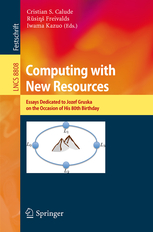
Enrico Formenti, Katsunobu Imai, Bruno Martin, Jean-Baptiste Yunès
Advances on random sequence generation by uniform cellular automata Book Section
Dans: C. Calude C., R. Freivalds R., I. Kazuo (Ed.): Computing with New Resources. Lecture Notes in Computer Science., vol. 8808, p. 56–70, Springer, Cham, 2014, ISBN: 978-3-319-13350-8.
@incollection{formenti2014advances,
title = {Advances on random sequence generation by uniform cellular automata},
author = {Enrico Formenti and Katsunobu Imai and Bruno Martin and Jean-Baptiste Yunès},
editor = {C. Calude C. and R. Freivalds R. and I. Kazuo},
doi = {10.1007/978-3-319-13350-8_5},
isbn = {978-3-319-13350-8},
year = {2014},
date = {2014-12-10},
booktitle = {Computing with New Resources. Lecture Notes in Computer Science.},
volume = {8808},
pages = {56--70},
publisher = {Springer, Cham},
abstract = {The study of cellular automata rules suitable for cryptographic applications is under consideration. On one hand, cellular automata can be used to generate pseudo-random sequences as well as for the design of S-boxes in symmetric cryptography. On the other hand, Boolean functions with good properties like resiliency and non-linearity are usually obtained either by exhaustive search or by the use of genetic algorithms. We propose here to use some recent research in the classification of Boolean functions and to link it with the study of cellular automata rules. As a consequence of our technique, this also provides a mean to get Boolean functions with good cryptographic properties.},
keywords = {},
pubstate = {published},
tppubtype = {incollection}
}
The study of cellular automata rules suitable for cryptographic applications is under consideration. On one hand, cellular automata can be used to generate pseudo-random sequences as well as for the design of S-boxes in symmetric cryptography. On the other hand, Boolean functions with good properties like resiliency and non-linearity are usually obtained either by exhaustive search or by the use of genetic algorithms. We propose here to use some recent research in the classification of Boolean functions and to link it with the study of cellular automata rules. As a consequence of our technique, this also provides a mean to get Boolean functions with good cryptographic properties.
Roberto Mantaci, Paolo Massazza, Jean-Baptiste Yunès
An Efficient Algorithm for Generating Symmetric Ice Piles Proceedings Article
Dans: Stefano Bistarelli, Andrea Formisano (Ed.): 15th Italian Conference on Theoretical Computer Science, Perugia, Italy, September 17-19, 2014, p. 15–170, 2014, ISSN: 1613-0073.
@inproceedings{ictcs2014,
title = {An Efficient Algorithm for Generating Symmetric Ice Piles},
author = {Roberto Mantaci and Paolo Massazza and Jean-Baptiste Yunès},
editor = {Stefano Bistarelli and Andrea Formisano},
url = {http://www.dmi.unipg.it/ictcs2014/},
issn = {1613-0073},
year = {2014},
date = {2014-09-17},
booktitle = {15th Italian Conference on Theoretical Computer Science, Perugia, Italy, September 17-19, 2014},
pages = {15--170},
keywords = {},
pubstate = {published},
tppubtype = {inproceedings}
}
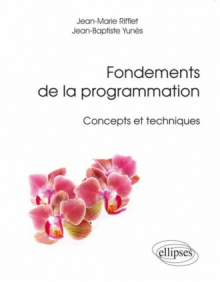
Jean-Marie Rifflet, Jean-Baptiste Yunès
Fondements de la Programmation Concepts et Techniques Ouvrage
Ellipses, 2014, ISBN: 9782340000148.
@book{rifflet2014fondements,
title = {Fondements de la Programmation Concepts et Techniques},
author = {Jean-Marie Rifflet and Jean-Baptiste Yunès},
url = {https://www.editions-ellipses.fr/accueil/8629-fondements-de-la-programmation-concepts-et-techniques-9782340000148.html#description-scroll-tricks},
isbn = {9782340000148},
year = {2014},
date = {2014-08-26},
publisher = {Ellipses},
abstract = {Cet ouvrage, à l’usage de tout informaticien, du programmeur à l’ingénieur, a pour but de fixer plus profondément un certain nombre de concepts de programmation. Ce livre n’est pas un manuel de programmation au sens traditionnel. On n’y trouvera pas l’habituelle litanie des arcanes syntaxiques de tel ou tel langage, d’abord parce qu’il ne se focalise pas sur un langage en particulier et ensuite parce qu’il ne se préoccupe pas de ces questions largement traitées par ailleurs. Son but est de cerner au travers d’exemples très nombreux, plus de 120 programmes documentés et décortiqués, quelques concepts essentiels de la programmation :
– les notions de variables, pointeurs, références, tableaux et structures qui prennent des formes variées et s’utilisent différemment selon les langages
– le concept de fonctions, appels de fonctions, transmissions de paramètres et renvois de valeurs
– la structure de pile et ses usages
– la récursion, ses différentes formes, ses avantages et inconvénients.
L’approche proposée est volontairement pragmatique, presque aucun formalisme n’est utilisé. Il s’agit d’écrire des programmes dans divers langages couramment utilisés (principalement Java, C, C++ mais pas seulement) illustrant des concepts, de les traduire vers une machine virtuelle simple permettant de comprendre comment ces constructions s’incarnent en machine et donc quels sont leurs impacts sur l’exécution des programmes : performance ou fiabilité par exemple. Par conséquent, le lecteur, qu’il soit débutant ou confirmé, sera par la suite capable de faire des choix bien éclairés et de mieux conduire sa conception de programmes.
Les codes sources des programmes peuvent être retrouvés sur Internet à partir des pages des auteurs.},
keywords = {},
pubstate = {published},
tppubtype = {book}
}
Cet ouvrage, à l’usage de tout informaticien, du programmeur à l’ingénieur, a pour but de fixer plus profondément un certain nombre de concepts de programmation. Ce livre n’est pas un manuel de programmation au sens traditionnel. On n’y trouvera pas l’habituelle litanie des arcanes syntaxiques de tel ou tel langage, d’abord parce qu’il ne se focalise pas sur un langage en particulier et ensuite parce qu’il ne se préoccupe pas de ces questions largement traitées par ailleurs. Son but est de cerner au travers d’exemples très nombreux, plus de 120 programmes documentés et décortiqués, quelques concepts essentiels de la programmation :
– les notions de variables, pointeurs, références, tableaux et structures qui prennent des formes variées et s’utilisent différemment selon les langages
– le concept de fonctions, appels de fonctions, transmissions de paramètres et renvois de valeurs
– la structure de pile et ses usages
– la récursion, ses différentes formes, ses avantages et inconvénients.
L’approche proposée est volontairement pragmatique, presque aucun formalisme n’est utilisé. Il s’agit d’écrire des programmes dans divers langages couramment utilisés (principalement Java, C, C++ mais pas seulement) illustrant des concepts, de les traduire vers une machine virtuelle simple permettant de comprendre comment ces constructions s’incarnent en machine et donc quels sont leurs impacts sur l’exécution des programmes : performance ou fiabilité par exemple. Par conséquent, le lecteur, qu’il soit débutant ou confirmé, sera par la suite capable de faire des choix bien éclairés et de mieux conduire sa conception de programmes.
Les codes sources des programmes peuvent être retrouvés sur Internet à partir des pages des auteurs.

Luidnel Maignan, Jean-Baptiste Yunès
Generalized FSSP on hexagonal tiling: Towards arbitrary regular spaces Proceedings Article
Dans: Teijiro Isokawa, Katsunobu Imai, Nobuyuki Matsui, Ferdinand Peper, Hiroshi Umeo (Ed.): Cellular Automata and Discrete Complex Systems. AUTOMATA 2014. Himeji, Japan, July 7th-9th, 2014. LNCS 8996. , p. 83–96, Springer, Cham 2014, ISBN: 978-3-319-18812-6.
@inproceedings{maignan2014generalized,
title = {Generalized FSSP on hexagonal tiling: Towards arbitrary regular spaces},
author = {Luidnel Maignan and Jean-Baptiste Yunè}s},
editor = {Teijiro Isokawa and Katsunobu Imai and Nobuyuki Matsui and Ferdinand Peper and Hiroshi Umeo},
doi = {10.1007/978-3-319-18812-6_7},
isbn = {978-3-319-18812-6},
year = {2014},
date = {2014-07-07},
booktitle = {Cellular Automata and Discrete Complex Systems. AUTOMATA 2014. Himeji, Japan, July 7th-9th, 2014. LNCS 8996. },
pages = {83--96},
organization = {Springer, Cham},
abstract = {Here we present a solution to the generalized firing squad synchronization problem that works on some class of shapes in the hexagonal tiling of the plane. The solution is obtained from a previous solution which works on grids with either a von Neumann or a Moore neighborhood. Analyzing the construction of this previous solution, we were able to exhibit a parameter that leads us to abstract the solution. First, and for an arbitrary considered neighborhood, we focus our attention on a class of shapes built from this neighborhood, and determine the corresponding parameter value for them. Second, we apply our previous solution with the determined parameter value for the hexagonal neighborhood and show that, indeed, all the considered shapes on the hexagonal tiling synchronizes.},
keywords = {},
pubstate = {published},
tppubtype = {inproceedings}
}
Here we present a solution to the generalized firing squad synchronization problem that works on some class of shapes in the hexagonal tiling of the plane. The solution is obtained from a previous solution which works on grids with either a von Neumann or a Moore neighborhood. Analyzing the construction of this previous solution, we were able to exhibit a parameter that leads us to abstract the solution. First, and for an arbitrary considered neighborhood, we focus our attention on a class of shapes built from this neighborhood, and determine the corresponding parameter value for them. Second, we apply our previous solution with the determined parameter value for the hexagonal neighborhood and show that, indeed, all the considered shapes on the hexagonal tiling synchronizes.

David Ameisen, Christophe Deroulers, Valérie Perrier, Fatiha Bouhidel, Maxime Battistella, Luc Legrès, Anne Janin, Philippe Bertheau, Jean-Baptiste Yunès
Automatic image quality assessment in digital pathology: from idea to implementation. En ligne
2014, Visité: 07.04.2014.
@online{ameisen2014automatic,
title = {Automatic image quality assessment in digital pathology: from idea to implementation.},
author = {David Ameisen and Christophe Deroulers and Valérie Perrier and Fatiha Bouhidel and Maxime Battistella and Luc Legrès and Anne Janin and Philippe Bertheau and Jean-Baptiste Yunès},
url = {http://iwbbio.ugr.es/2014/papers/IWBBIO_2014_paper_18.pdf},
year = {2014},
date = {2014-04-07},
urldate = {2014-04-07},
booktitle = {IWBBIO 2014 (2nd International Work-Conference on Bioinformatics and Biomedical Engineering)},
pages = {148--157},
abstract = {At this time, the quality of a Whole Slide Image (WSI) is verified a posteriori by a technician or a pathologist. A WSI of insufficient quality needs to be scanned again. High-speed automatic quality assessment tools for WSI will therefore greatly improve laboratory workflow. We describe here a fast method to automatically assess WSI quality, with different tests such as blurri- ness, contrast, brightness and color, and to accept or discard them at the time of acquisition in less than a minute. Parameters are weighted by pertinence and a global score indicates whether the WSI is suitable for further use. This fast method, designed at first to improve laboratory workflow, is currently being implemented in a network of 27 French hospitals and public-private health in- stitutions in the Paris region. It may also be used as a calibration and quality control tool for WSI acquisition systems.},
keywords = {},
pubstate = {published},
tppubtype = {online}
}
At this time, the quality of a Whole Slide Image (WSI) is verified a posteriori by a technician or a pathologist. A WSI of insufficient quality needs to be scanned again. High-speed automatic quality assessment tools for WSI will therefore greatly improve laboratory workflow. We describe here a fast method to automatically assess WSI quality, with different tests such as blurri- ness, contrast, brightness and color, and to accept or discard them at the time of acquisition in less than a minute. Parameters are weighted by pertinence and a global score indicates whether the WSI is suitable for further use. This fast method, designed at first to improve laboratory workflow, is currently being implemented in a network of 27 French hospitals and public-private health in- stitutions in the Paris region. It may also be used as a calibration and quality control tool for WSI acquisition systems.

Luidnel Maignan, Jean-Baptiste Yunès
Experimental finitization of infinite field-based generalized FSSP solution Proceedings Article
Dans: Jarosalw Wąs, Giorgos Sirakoulis, Stefania Bandini (Ed.): International Conference on Cellular Automata, ACRI 2014: Cellular Automata, LNCS., p. 136–145, Springer, Cham 2014, ISBN: 978-3-319-11520-7.
@inproceedings{maignan2014experimental,
title = {Experimental finitization of infinite field-based generalized FSSP solution},
author = {Luidnel Maignan and Jean-Baptiste Yunès},
editor = {Jarosalw Wąs and Giorgos Sirakoulis and Stefania Bandini},
doi = {10.1007/978-3-319-11520-7_15},
isbn = {978-3-319-11520-7},
year = {2014},
date = {2014-01-01},
booktitle = {International Conference on Cellular Automata, ACRI 2014: Cellular Automata, LNCS.},
volume = {8751},
pages = {136--145},
organization = {Springer, Cham},
abstract = {In a previous work (see [3]) we presented a general scheme to solve the 1D Generalized Firing Squad Synchronization Problem. We designed it in a modular way using the concept of fields (open CA). The solution was not designed as a finite cellular automaton because we needed unbounded integers as states for distance fields, and the recursive nature of the algorithm leaded to a unbounded number of fields. In this paper, we show as claimed, that this approach does lead to a finite cellular automaton. We exhibit a transformation function from infinite to finite states and write a program that generates the associated finite transition table while checking its validity and the conservation of the input-output behavior of the original cellular automaton.},
keywords = {},
pubstate = {published},
tppubtype = {inproceedings}
}
In a previous work (see [3]) we presented a general scheme to solve the 1D Generalized Firing Squad Synchronization Problem. We designed it in a modular way using the concept of fields (open CA). The solution was not designed as a finite cellular automaton because we needed unbounded integers as states for distance fields, and the recursive nature of the algorithm leaded to a unbounded number of fields. In this paper, we show as claimed, that this approach does lead to a finite cellular automaton. We exhibit a transformation function from infinite to finite states and write a program that generates the associated finite transition table while checking its validity and the conservation of the input-output behavior of the original cellular automaton.
2013

Luidnel Maignan, Jean-Baptiste Yunès
Moore and von Neumann neighborhood n-dimensional generalized firing squad solutions using fields Proceedings Article
Dans: 2013 First International Symposium on Computing and Networking, Matsuyama, Japan, 2013, p. 552–558, IEEE 2013.
@inproceedings{maignan2013moore,
title = {Moore and von Neumann neighborhood n-dimensional generalized firing squad solutions using fields},
author = {Luidnel Maignan and Jean-Baptiste Yunès},
doi = {10.1109/CANDAR.2013.98},
year = {2013},
date = {2013-12-04},
booktitle = {2013 First International Symposium on Computing and Networking, Matsuyama, Japan, 2013},
pages = {552--558},
organization = {IEEE},
abstract = {We present a solution to the Firing Squad Synchronization Problem that works both in Von Neumann and Moore neighborhood and whatever is the dimension of the space. That solution is based on fields that provide a clean modular decomposition of such cellular automata problem.},
keywords = {},
pubstate = {published},
tppubtype = {inproceedings}
}
We present a solution to the Firing Squad Synchronization Problem that works both in Von Neumann and Moore neighborhood and whatever is the dimension of the space. That solution is based on fields that provide a clean modular decomposition of such cellular automata problem.

David Ameisen, Christophe Deroulers, Valérie Perrier, Jean-Baptiste Yunès, Fatiha Bouhidel, Maxime Battistella, Luc Legrès, Anne Janin, Philippe Bertheau
Stack or trash? Quality assessment of virtual slides Proceedings Article
Dans: Diagnostic Pathology: Proceedings of the 11th European Congress on Telepathology and 5th International Congress on Virtual Microscopy, p. S23, BioMed Central 2013.
@inproceedings{ameisen2013stack,
title = {Stack or trash? Quality assessment of virtual slides},
author = {David Ameisen and Christophe Deroulers and Valérie Perrier and Jean-Baptiste Yunès and Fatiha Bouhidel and Maxime Battistella and Luc Legrès and Anne Janin and Philippe Bertheau},
doi = {10.1186/1746-1596-8-S1-S23},
year = {2013},
date = {2013-09-30},
booktitle = {Diagnostic Pathology: Proceedings of the 11th European Congress on Telepathology and 5th International Congress on Virtual Microscopy},
volume = {8},
number = {1},
pages = {S23},
organization = {BioMed Central},
abstract = {Since microscopic slides can now be automatically digitized and integrated in the clinical workflow, quality assessment of these Whole Slide Images (WSI) has become a crucial issue. At this time, the quality of a WSI is verified a posteriori by a technician or by a pathologist. There is however a significant amount of WSI that are too insufficient in quality (blurred, bad colors, poor contrast.) to be used for diagnoses. These slides have then to be scanned again with delay thus slowing down the diagnostic workflow.
To address this problem, we chose to design a method of quality assessment followed by reacquisition, as opposed to a process of enhancement or restoration [1, 2]. Such process indeed too frequently results in the degradation of image quality, a key factor in medical diagnosis.
The quality of a flat image can be defined by several quantifiable parameters such as color, brightness, and contrast. One of the most important parameters, yet difficult to assess, is the focus sharpness (i.e. the level of focus blur) [3]).
Quality assessment of WSI is much more complex than that of flat images because of their intrinsic structure made of multiple magnification levels (pyramidal structure) and resolutions above the gigapixel. One study [4] has shown the possibility of comparing the tiles’ contrast and entropy in two WSI obtained with two different scanners digitizing the same slide. Another work [5] assessed the focus sharpness of the tiles of a WSI with the generation of a focus assessment map of the WSI at a given magnification level. However, both these methods still require a human eye to assess if the WSI must be accepted or discarded after the scan.
We describe here a fast method to automatically assess quality and to accept or discard WSI at the time of acquisition.},
keywords = {},
pubstate = {published},
tppubtype = {inproceedings}
}
Since microscopic slides can now be automatically digitized and integrated in the clinical workflow, quality assessment of these Whole Slide Images (WSI) has become a crucial issue. At this time, the quality of a WSI is verified a posteriori by a technician or by a pathologist. There is however a significant amount of WSI that are too insufficient in quality (blurred, bad colors, poor contrast.) to be used for diagnoses. These slides have then to be scanned again with delay thus slowing down the diagnostic workflow.
To address this problem, we chose to design a method of quality assessment followed by reacquisition, as opposed to a process of enhancement or restoration [1, 2]. Such process indeed too frequently results in the degradation of image quality, a key factor in medical diagnosis.
The quality of a flat image can be defined by several quantifiable parameters such as color, brightness, and contrast. One of the most important parameters, yet difficult to assess, is the focus sharpness (i.e. the level of focus blur) [3]).
Quality assessment of WSI is much more complex than that of flat images because of their intrinsic structure made of multiple magnification levels (pyramidal structure) and resolutions above the gigapixel. One study [4] has shown the possibility of comparing the tiles’ contrast and entropy in two WSI obtained with two different scanners digitizing the same slide. Another work [5] assessed the focus sharpness of the tiles of a WSI with the generation of a focus assessment map of the WSI at a given magnification level. However, both these methods still require a human eye to assess if the WSI must be accepted or discarded after the scan.
We describe here a fast method to automatically assess quality and to accept or discard WSI at the time of acquisition.
2012
David Ameisen, Christophe Deroulers, Valérie Perrier, Jean-Baptiste Yunès, F Bouhidel, M Battistella, L Legrès, Anne Janin, Philippe Bertheau
À prendre ou à laisser? Une évaluation automatique de la qualité des lames virtuelles en temps quasi-réel Proceedings Article
Dans: Annales de Pathologie, p. S151–S152, Elsevier Masson 2012.
@inproceedings{ameisen2012prendre,
title = {À prendre ou à laisser? Une évaluation automatique de la qualité des lames virtuelles en temps quasi-réel},
author = {David Ameisen and Christophe Deroulers and Valérie Perrier and Jean-Baptiste Yunès and F Bouhidel and M Battistella and L Legrès and Anne Janin and Philippe Bertheau},
year = {2012},
date = {2012-11-01},
booktitle = {Annales de Pathologie},
volume = {32},
number = {5},
pages = {S151--S152},
organization = {Elsevier Masson},
abstract = {Discussion.–Notre prototype pourra notamment être amélioré en augmentant la vitesse d’analyse grâce à une architecture en grappe de serveurs (cluster). Un algorithme d’apprentissage permettrait par ailleurs d’affiner les seuils en fonction des colorations et du type de système d’acquisition.
Conclusion.–Notre méthode peut être utilisée en amont comme un outil de calibration ou d’assurance qualité pour les systèmes d’acquisition de LV ou comme outil en temps réel pour numériser à nouveau les tuiles lors de la numérisation. Elle peut également être utilisée en aval pour détecter les lames de qualité insuffisante et permettre leur renumérisation avant analyse par le pathologiste. Ces scores pourraient être intégrés, en tant qu’indicateurs de qualité, aux métadonnées des LV partagées dans les contextes de recherche, d’enseignement ou clinique.},
keywords = {},
pubstate = {published},
tppubtype = {inproceedings}
}
Discussion.–Notre prototype pourra notamment être amélioré en augmentant la vitesse d’analyse grâce à une architecture en grappe de serveurs (cluster). Un algorithme d’apprentissage permettrait par ailleurs d’affiner les seuils en fonction des colorations et du type de système d’acquisition.
Conclusion.–Notre méthode peut être utilisée en amont comme un outil de calibration ou d’assurance qualité pour les systèmes d’acquisition de LV ou comme outil en temps réel pour numériser à nouveau les tuiles lors de la numérisation. Elle peut également être utilisée en aval pour détecter les lames de qualité insuffisante et permettre leur renumérisation avant analyse par le pathologiste. Ces scores pourraient être intégrés, en tant qu’indicateurs de qualité, aux métadonnées des LV partagées dans les contextes de recherche, d’enseignement ou clinique.
Jacques Mazoyer, Jean-Baptiste Yunès
Computations on cellular automata Chapitre d'ouvrage
Dans: Grzegorz Rozenberg (Ed.): Handbook of Natural Computing, p. 159–188, Springer Berlin Heidelberg, 2012, ISBN: 978-3-540-92911-6.
@inbook{mazoyer2012computations,
title = {Computations on cellular automata},
author = {Jacques Mazoyer and Jean-Baptiste Yunès},
editor = {Grzegorz Rozenberg},
isbn = {978-3-540-92911-6},
year = {2012},
date = {2012-08-01},
booktitle = {Handbook of Natural Computing},
pages = {159--188},
publisher = {Springer Berlin Heidelberg},
keywords = {},
pubstate = {published},
tppubtype = {inbook}
}
Luidnel Maignan, Jean-Baptiste Yunès
Recursivity in Field-based Programming: the Firing Squad Example. Proceedings Article
Dans: Workshop on Spatial Computing International Conference on Autonomous Agents and MultiAgent Systems, Valencia, Spain, 2012.
@inproceedings{Maignan2012,
title = {Recursivity in Field-based Programming: the Firing Squad Example.},
author = {Luidnel Maignan and Jean-Baptiste Yunès},
url = {https://hal.science/hal-02420182},
year = {2012},
date = {2012-06-01},
urldate = {2012-06-01},
booktitle = {Workshop on Spatial Computing International Conference on Autonomous Agents and MultiAgent Systems},
address = {Valencia, Spain},
keywords = {},
pubstate = {published},
tppubtype = {inproceedings}
}
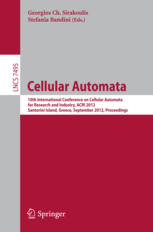
Luidnel Maignan, Jean-Baptiste Yunès
A spatio-temporal algorithmic point of view on firing squad synchronisation problem Proceedings Article
Dans: Georgios Sirakoulis, Stefania Bandini (Ed.): International Conference on Cellular Automata, Cellular Automata. ACRI 2012, Santorini Island, Greece. Lecture Notes in Computer Science, LNCS., p. 101–110, Springer, Berlin, Heidelberg 2012, ISBN: 978-3-642-33350-7.
@inproceedings{maignan2012spatio,
title = {A spatio-temporal algorithmic point of view on firing squad synchronisation problem},
author = {Luidnel Maignan and Jean-Baptiste Yunès},
editor = {Georgios Sirakoulis and Stefania Bandini},
doi = {10.1007/978-3-642-33350-7_11},
isbn = {978-3-642-33350-7},
year = {2012},
date = {2012-01-01},
booktitle = {International Conference on Cellular Automata, Cellular Automata. ACRI 2012, Santorini Island, Greece. Lecture Notes in Computer Science, LNCS.},
volume = {7495},
pages = {101--110},
organization = {Springer, Berlin, Heidelberg},
abstract = {Firing Squad Synchronization Problems are well known to be solvable by voluminous transition tables describing signals traveling and colliding. In this paper, we show that it is possible to solve it by expressing directly the fact that we want a recursive division of the space into two parts of equal size, and a notification when no further division is possible. Using fields – objects associating a value to every point in space and time – as primitive objects, the solution is designed algorithmically by a semantically-intuitive decomposition of the global evolution into simpler evolutions.
The system we obtain has several interesting characteristics : it is understandable, time-optimal, tackles many initial configurations, and allows a new interpretation of the traditional signals and collisions point of view. We will quickly sketch how we can obtain a finite state automaton by reduction of the system using the Lipschitz-continuity of involved fields, and a kind of tail-recursivity property of the dependencies.},
keywords = {},
pubstate = {published},
tppubtype = {inproceedings}
}
Firing Squad Synchronization Problems are well known to be solvable by voluminous transition tables describing signals traveling and colliding. In this paper, we show that it is possible to solve it by expressing directly the fact that we want a recursive division of the space into two parts of equal size, and a notification when no further division is possible. Using fields – objects associating a value to every point in space and time – as primitive objects, the solution is designed algorithmically by a semantically-intuitive decomposition of the global evolution into simpler evolutions.
The system we obtain has several interesting characteristics : it is understandable, time-optimal, tackles many initial configurations, and allows a new interpretation of the traditional signals and collisions point of view. We will quickly sketch how we can obtain a finite state automaton by reduction of the system using the Lipschitz-continuity of involved fields, and a kind of tail-recursivity property of the dependencies.

Jean-Baptiste Yunès
Grids and universal computations on one-dimensional cellular automata Article de journal
Dans: Natural Computing, vol. 11, no. 2, p. 303–309, 2012.
@article{yunes2012grids,
title = {Grids and universal computations on one-dimensional cellular automata},
author = {Jean-Baptiste Yunès},
editor = {Yasubumi Sakakibara and Yongli Mi and Svozil and Dennunzio and Enrico Formenti and Ferdinand Peper and Hiroshi Umeo},
doi = {10.1007/s11047-012-9312-2},
year = {2012},
date = {2012-01-01},
journal = {Natural Computing},
volume = {11},
number = {2},
pages = {303--309},
publisher = {Springer},
abstract = {This article shows how universal computations can be achieved on one-dimensional cellular automata. We are interested in intrinsic universality: we want a CA in which any other CA can be represented and simulated with no intermediate coding relevant to another computation model. We first abstract the space-time diagram in favor of the dependency graph. Then we show how such a dependency graph (via treillis automata) can be realized by what is called a grid, leading to a simple uniform simulation. Finally, we exhibit a very simple universal brick that can be used in grids to obtain an intrinsic universal CA.},
keywords = {},
pubstate = {published},
tppubtype = {article}
}
This article shows how universal computations can be achieved on one-dimensional cellular automata. We are interested in intrinsic universality: we want a CA in which any other CA can be represented and simulated with no intermediate coding relevant to another computation model. We first abstract the space-time diagram in favor of the dependency graph. Then we show how such a dependency graph (via treillis automata) can be realized by what is called a grid, leading to a simple uniform simulation. Finally, we exhibit a very simple universal brick that can be used in grids to obtain an intrinsic universal CA.
2011

Enrico Formenti, Katsunobu Imai, Bruno Martin, Jean-Baptiste Yunes
On 1-resilient, radius 2 elementary CA rules Proceedings Article
Dans: Nazim Fatès, Eric Goles, Alejandro Maass, Ivan Rapaport
(Ed.): AUTOMATA 2011, 17th International Workshop on Cellular Automata and Discrete Complex Systems, Nancy, France., p. 41–54, 2011.
@inproceedings{formenti20111,
title = {On 1-resilient, radius 2 elementary CA rules},
author = {Enrico Formenti and Katsunobu Imai and Bruno Martin and Jean-Baptiste Yunes},
editor = {Nazim Fatès and Eric Goles and Alejandro Maass and Ivan Rapaport
},
url = {https://hal.inria.fr/hal-00654706/document},
year = {2011},
date = {2011-11-21},
booktitle = {AUTOMATA 2011, 17th International Workshop on Cellular Automata and Discrete Complex Systems, Nancy, France.},
journal = {AUTOMATA 2011},
pages = {41--54},
abstract = {The study of cellular automata rules suitable for cryptographic applications is under consideration. Cellular automata can be used to generate pseudo-random sequences as well as for the design of S-boxes in symmetric cryptography. Boolean functions with good properties like resiliency and non-linearity are usually obtained either by exhaustive search or by the use of genetic algorithms. We propose here to use some recent research in the classification of Boolean functions and to link the study of cellular automata rules to the study of such Boolean functions. We illustrate our approach with 5-variable Boolean functions.},
keywords = {},
pubstate = {published},
tppubtype = {inproceedings}
}
The study of cellular automata rules suitable for cryptographic applications is under consideration. Cellular automata can be used to generate pseudo-random sequences as well as for the design of S-boxes in symmetric cryptography. Boolean functions with good properties like resiliency and non-linearity are usually obtained either by exhaustive search or by the use of genetic algorithms. We propose here to use some recent research in the classification of Boolean functions and to link the study of cellular automata rules to the study of such Boolean functions. We illustrate our approach with 5-variable Boolean functions.
Enrico Formenti, Katsunobu Imai, Bruno Martin, Jean-Baptiste Yunès
Cellular automata, Boolean functions, Pseudo-random generators, Symmetric cryptography. Proceedings Article
Dans: Nazim Fatès, Eric Goles, Alejandro Maass, Ivan Rappaport (Ed.): AUTOMATA 11, 17th International Workshop on Cellular Automata and Discrete Complex Systems, November 21—23, 2011, Santiago, Chile., 2011.
@inproceedings{formenti2011boolean,
title = {Cellular automata, Boolean functions, Pseudo-random generators, Symmetric cryptography.},
author = {Enrico Formenti and Katsunobu Imai and Bruno Martin and Jean-Baptiste Yunès},
editor = {Nazim Fatès and Eric Goles and Alejandro Maass and Ivan Rappaport},
year = {2011},
date = {2011-11-21},
booktitle = {AUTOMATA 11, 17th International Workshop on Cellular Automata and Discrete Complex Systems, November 21—23, 2011, Santiago, Chile.},
keywords = {},
pubstate = {published},
tppubtype = {inproceedings}
}
Jean-Baptiste Yunès
Le premier programme informatique de von Neumann Chapitre d'ouvrage
Dans: Éléments pour une histoire de l'informatique.
Traduction d'œuvres choisies de Donald E. Knuth.
Traduction dirigée par Patrick Cégielski., p. 56–75, Société Mathématique de France-CSLI Publications, Stanford, California, 2011, ISBN: 978-1-57586-622-2.
@inbook{yunes2011premier,
title = {Le premier programme informatique de von Neumann},
author = {Jean-Baptiste Yunès},
isbn = {978-1-57586-622-2},
year = {2011},
date = {2011-01-01},
booktitle = {Éléments pour une histoire de l'informatique.
Traduction d'œuvres choisies de Donald E. Knuth.
Traduction dirigée par Patrick Cégielski.},
pages = {56--75},
publisher = {Société Mathématique de France-CSLI Publications, Stanford, California},
keywords = {},
pubstate = {published},
tppubtype = {inbook}
}
2010
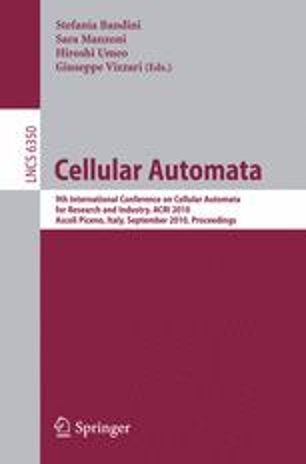
Jean-Baptiste Yunès
Achieving universal computations on one-dimensional cellular automata (invited conference) Proceedings Article
Dans: Hiroshi Umeo, Stefania Bandini (Ed.): Cellular Automata. ACRI 2010. Ascoli Piceno, Italy, Septembre 21-24, 2010. Lecture Notes in Computer Science, LNCS, p. 660–669, Springer, Berlin, Heidelberg 2010, ISBN: 978-3-642-15979-4.
@inproceedings{yunes2010achieving,
title = {Achieving universal computations on one-dimensional cellular automata (invited conference)},
author = {Jean-Baptiste Yunès},
editor = {Hiroshi Umeo and Stefania Bandini},
doi = {10.1007/978-3-642-15979-4_74},
isbn = {978-3-642-15979-4},
year = {2010},
date = {2010-09-21},
booktitle = {Cellular Automata. ACRI 2010. Ascoli Piceno, Italy, Septembre 21-24, 2010. Lecture Notes in Computer Science, LNCS},
volume = {6350},
pages = {660--669},
organization = {Springer, Berlin, Heidelberg},
abstract = {We show how natural universal computations can be achieved on one-dimensional cellular automata. That model of computation is obviously Turing complete but how can we effectively program any given computation is far less known. In this paper we are interested in intrinsic universality; we want a CA in which any other CA can be represented and simulated with no intermediate coding relevant to another computation model. The first step is to abstract from the space-time diagram in favor of a more essential dependency graph. Then such dependency graph can be projected on grids. This work shows that grids put forward causality in place of space-time contingencies.},
keywords = {},
pubstate = {published},
tppubtype = {inproceedings}
}
We show how natural universal computations can be achieved on one-dimensional cellular automata. That model of computation is obviously Turing complete but how can we effectively program any given computation is far less known. In this paper we are interested in intrinsic universality; we want a CA in which any other CA can be represented and simulated with no intermediate coding relevant to another computation model. The first step is to abstract from the space-time diagram in favor of a more essential dependency graph. Then such dependency graph can be projected on grids. This work shows that grids put forward causality in place of space-time contingencies.

Akira Nomura, Jean-Baptiste Yunès, Hiroshi Umeo
A Note on Synchronization Steps in Firing Squad Synchronization Problem Proceedings Article
Dans: 2010 Third International Joint Conference on Computational Science and Optimization, Huangshan, China., p. 300–301, IEEE 2010, ISBN: 978-1-4244-6812-6.
@inproceedings{nomura2010note,
title = {A Note on Synchronization Steps in Firing Squad Synchronization Problem},
author = {Akira Nomura and Jean-Baptiste Yunès and Hiroshi Umeo},
doi = {10.1109/CSO.2010.124},
isbn = {978-1-4244-6812-6},
year = {2010},
date = {2010-05-28},
booktitle = {2010 Third International Joint Conference on Computational Science and Optimization, Huangshan, China.},
volume = {1},
pages = {300--301},
organization = {IEEE},
abstract = {The firing squad synchronization problem on cellular automata has been studied extensively for more than forty years, and a rich variety of synchronization algorithms have been proposed. In this paper, we propose two synchronization algorithms and their implementations, each having O(n^2) and O(2^n) synchronization steps for n cells, respectively.},
keywords = {},
pubstate = {published},
tppubtype = {inproceedings}
}
The firing squad synchronization problem on cellular automata has been studied extensively for more than forty years, and a rich variety of synchronization algorithms have been proposed. In this paper, we propose two synchronization algorithms and their implementations, each having O(n^2) and O(2^n) synchronization steps for n cells, respectively.
2009

Hiroshi Umeo, Jean-Baptiste Yunès, Naoki Kamikawa, Juntarou Kurashiki
Small non optimum time firing squad synchronization protocols for one-dimensional rings Proceedings Article
Dans: International Symposium on Nonlinear Theory and its Applications (NOLTA'09). Sapporo, Japan, October 18—21, 2009., p. 479–482, 2009.
@inproceedings{umeo2009small,
title = {Small non optimum time firing squad synchronization protocols for one-dimensional rings},
author = {Hiroshi Umeo and Jean-Baptiste Yunès and Naoki Kamikawa and Juntarou Kurashiki},
year = {2009},
date = {2009-10-18},
booktitle = {International Symposium on Nonlinear Theory and its Applications (NOLTA'09). Sapporo, Japan, October 18—21, 2009.},
volume = {9},
pages = {479--482},
abstract = {The synchronization in cellular automata has been known as a firing squad synchronization problem since its development, in which it was originally pro- posed by J. Myhill in Moore [1964] to synchronize all or some parts of self-reproducing cellular automata. The firing squad synchronization problem has been studied extensively for more than 40 years [1-22]. In the present article, we propose two six-state firing squad synchronization full protocols for rings, which are the smallest ones known at present for rings. In addition, we present a family of 4-state partial protocols that can synchronize any one-dimensional rings of length n = 2^k for any positive integer k. The number four is the smallest one in the class of synchronization protocols proposed so far. We also study state change complexities for those protocols.},
keywords = {},
pubstate = {published},
tppubtype = {inproceedings}
}
The synchronization in cellular automata has been known as a firing squad synchronization problem since its development, in which it was originally pro- posed by J. Myhill in Moore [1964] to synchronize all or some parts of self-reproducing cellular automata. The firing squad synchronization problem has been studied extensively for more than 40 years [1-22]. In the present article, we propose two six-state firing squad synchronization full protocols for rings, which are the smallest ones known at present for rings. In addition, we present a family of 4-state partial protocols that can synchronize any one-dimensional rings of length n = 2^k for any positive integer k. The number four is the smallest one in the class of synchronization protocols proposed so far. We also study state change complexities for those protocols.

Hiroshi Umeo, Jean-Baptiste Yunès, Takuya Yamawaki
A simple optimum-time firing squad synchronization algorithm for two-dimensional rectangle arrays Proceedings Article
Dans: 2009 International Conference on Computational Intelligence, Modelling and Simulation, Brno, Czech Republic, September 7—9, 2009., p. 120–125, IEEE 2009.
@inproceedings{umeo2009simple,
title = {A simple optimum-time firing squad synchronization algorithm for two-dimensional rectangle arrays},
author = {Hiroshi Umeo and Jean-Baptiste Yunès and Takuya Yamawaki},
doi = {10.1109/CSSim.2009.58},
year = {2009},
date = {2009-09-07},
booktitle = {2009 International Conference on Computational Intelligence, Modelling and Simulation, Brno, Czech Republic, September 7—9, 2009.},
pages = {120--125},
organization = {IEEE},
abstract = {The firing squad synchronization problem on cellular automata has been studied extensively for more than forty years, and a rich variety of synchronization algorithms have been proposed for not only one-dimensional arrays but two-dimensional arrays. In the present paper, we propose a new and simpler optimum-time synchronization algorithm that can synchronize any rectangle array of size m × n with a general at one corner in m + n + max(m, n)-3 steps. An implementation for the algorithm in terms of local transition rules is also given.},
keywords = {},
pubstate = {published},
tppubtype = {inproceedings}
}
The firing squad synchronization problem on cellular automata has been studied extensively for more than forty years, and a rich variety of synchronization algorithms have been proposed for not only one-dimensional arrays but two-dimensional arrays. In the present paper, we propose a new and simpler optimum-time synchronization algorithm that can synchronize any rectangle array of size m × n with a general at one corner in m + n + max(m, n)-3 steps. An implementation for the algorithm in terms of local transition rules is also given.
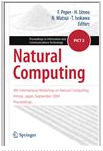
Hiroshi Umeo, Jean-Baptiste Yunès, Takuya Yamawaki
A Two-Dimensional Optimum-Time Firing Squad Synchronization Algorithm and Its Implementation Book Section
Dans: Ferdinand Peper, Hiroshi Umeo, N. Matsui, Teijiro Isokawa (Ed.): IWNC'09 — International Workshop on Natural Computing, Himeji, Japan, September 23—25, 2009, Proceedings in Information and Communications Technology., vol. 2, no. 3, p. 342–351, Springer, Tokyo, 2009.
@incollection{umeo2010two,
title = {A Two-Dimensional Optimum-Time Firing Squad Synchronization Algorithm and Its Implementation},
author = {Hiroshi Umeo and Jean-Baptiste Yunès and Takuya Yamawaki},
editor = {Ferdinand Peper and Hiroshi Umeo and N. Matsui and Teijiro Isokawa},
doi = {10.1007/978-4-431-53868-4},
year = {2009},
date = {2009-09-01},
booktitle = {IWNC'09 — International Workshop on Natural Computing, Himeji, Japan, September 23—25, 2009, Proceedings in Information and Communications Technology.},
volume = {2},
number = {3},
pages = {342--351},
publisher = {Springer, Tokyo},
abstract = {The firing squad synchronization problem on cellular automata has been studied extensively for more than forty years, and a rich variety of synchronization algorithms have been proposed for not only one-dimensional arrays but two-dimensional arrays. In the present paper, we propose a new and simpler optimum-time synchronization algorithm that can synchronize any rectangle array of size m ×n with a general at one corner in m + n + max (m, n) − 3 steps. An implementation for the algorithm in terms of local transition rules is also given.},
keywords = {},
pubstate = {published},
tppubtype = {incollection}
}
The firing squad synchronization problem on cellular automata has been studied extensively for more than forty years, and a rich variety of synchronization algorithms have been proposed for not only one-dimensional arrays but two-dimensional arrays. In the present paper, we propose a new and simpler optimum-time synchronization algorithm that can synchronize any rectangle array of size m ×n with a general at one corner in m + n + max (m, n) − 3 steps. An implementation for the algorithm in terms of local transition rules is also given.

Hiroshi Umeo, Naoki Kamikawa, Jean-Baptiste Yunès
A family of smallest symmetrical four-state firing squad synchronization protocols for ring arrays Article de journal
Dans: Parallel Processing Letters, vol. 19, no. 02, p. 299–313, 2009.
@article{umeo2009family,
title = {A family of smallest symmetrical four-state firing squad synchronization protocols for ring arrays},
author = {Hiroshi Umeo and Naoki Kamikawa and Jean-Baptiste Yunès},
doi = {10.1142/S0129626409000237},
year = {2009},
date = {2009-01-01},
journal = {Parallel Processing Letters},
volume = {19},
number = {02},
pages = {299--313},
publisher = {World Scientific},
abstract = {An existence or non-existence of five-state firing squad synchronization protocol has been a longstanding and famous open problem for a long time. In this paper, we answer partially to this problem by proposing a family of smallest four-state firing squad synchronization protocols that can synchronize any one-dimensional ring cellular arrays of length n = 2k for any positive integer k. The number four is the smallest one in the class of synchronization protocols proposed so far.},
keywords = {},
pubstate = {published},
tppubtype = {article}
}
An existence or non-existence of five-state firing squad synchronization protocol has been a longstanding and famous open problem for a long time. In this paper, we answer partially to this problem by proposing a family of smallest four-state firing squad synchronization protocols that can synchronize any one-dimensional ring cellular arrays of length n = 2k for any positive integer k. The number four is the smallest one in the class of synchronization protocols proposed so far.

Jean-Baptiste Yunès
Known CA synchronizers made insensitive to the initial state of the initiator Article de journal
Dans: Journal of Cellular Automata, vol. 4, no. 2, p. 147–158, 2009.
@article{yun2009known,
title = {Known CA synchronizers made insensitive to the initial state of the initiator},
author = {Jean-Baptiste Yunès},
editor = {Henryk Fuks and Anna T. Lawniczak},
url = {https://www.oldcitypublishing.com/journals/jca-home/jca-issue-contents/jca-volume-4-number-2-2009/jca-4-2-p-147-158/},
year = {2009},
date = {2009-01-01},
booktitle = {Special Issue. Automata 2007. 13th International Workshop on Cellular Automata.},
journal = {Journal of Cellular Automata},
volume = {4},
number = {2},
pages = {147--158},
abstract = {We show that a lot of CA synchronizers can be made insensitive to the initial state of the initiator by adding a few new transitions which were previously undefined and no new state.},
keywords = {},
pubstate = {published},
tppubtype = {article}
}
We show that a lot of CA synchronizers can be made insensitive to the initial state of the initiator by adding a few new transitions which were previously undefined and no new state.
2008
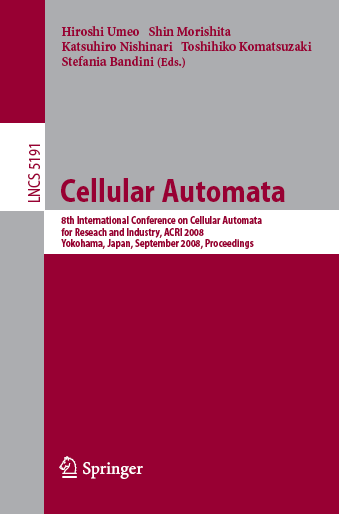
Hiroshi Umeo, Jean-Baptiste Yunès, Naoki Kamikawa
About 4-states solutions to the firing squad synchronization problem Proceedings Article
Dans: Hiroshi Umeo, Shin Morishita, Katsuhiro Nishinari, Toshihiko Komatsuzaki, Stefania Bandini (Ed.): Cellular Automata, 8th International Conference on Cellular Automata for Research and Industry, ACRI 2008, Yokohama, Japan, September 23—26, 2008. Proceedings. Lecture Notes on Computer Science, LNCS, p. 108–113, Springer, Berlin, Heidelberg 2008, ISBN: 978-3-540-79992-4.
@inproceedings{umeo20084,
title = {About 4-states solutions to the firing squad synchronization problem},
author = {Hiroshi Umeo and Jean-Baptiste Yunès and Naoki Kamikawa},
editor = {Hiroshi Umeo and Shin Morishita and Katsuhiro Nishinari and Toshihiko Komatsuzaki and Stefania Bandini},
doi = {10.1007/978-3-540-79992-4_14},
isbn = {978-3-540-79992-4},
year = {2008},
date = {2008-09-23},
booktitle = {Cellular Automata, 8th International Conference on Cellular Automata for Research and Industry, ACRI 2008, Yokohama, Japan, September 23—26, 2008. Proceedings. Lecture Notes on Computer Science, LNCS},
volume = {5191},
pages = {108--113},
organization = {Springer, Berlin, Heidelberg},
abstract = {We present some elements of a new family of time-optimal solutions to a less restrictive firing squad synchronization problem. These solutions are all built on top of some elementary algebraic cellular automata. Thus, this gives a very new insight on the problem and a more general way of computing on cellular automata.},
keywords = {},
pubstate = {published},
tppubtype = {inproceedings}
}
We present some elements of a new family of time-optimal solutions to a less restrictive firing squad synchronization problem. These solutions are all built on top of some elementary algebraic cellular automata. Thus, this gives a very new insight on the problem and a more general way of computing on cellular automata.
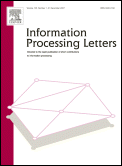
Jean-Baptiste Yunès
A 4-states algebraic solution to linear cellular automata synchronization Article de journal
Dans: Information Processing Letters, vol. 107, no. 2, p. 71–75, 2008.
@article{yunes20084,
title = {A 4-states algebraic solution to linear cellular automata synchronization},
author = {Jean-Baptiste Yunès},
doi = {10.1016/j.ipl.2008.01.009},
year = {2008},
date = {2008-07-16},
journal = {Information Processing Letters},
volume = {107},
number = {2},
pages = {71--75},
publisher = {Elsevier},
abstract = {In this paper, we aim to present a completely new solution to the firing squad synchronization problem based on Wolfram's rule 60. This solution solves the problem on an infinite number of lines but not all possible lines. The two remarkable properties are that the state complexity of it is the lowest possible, say 4 states and 32 transitions (we prove that no line of length
can be synchronized with only 3 states) and that the algorithm is no more based on geometric constructions but relies on some algebraic properties of the transition function. The solution is almost in minimal time: up to one unit of time.},
keywords = {},
pubstate = {published},
tppubtype = {article}
}
In this paper, we aim to present a completely new solution to the firing squad synchronization problem based on Wolfram's rule 60. This solution solves the problem on an infinite number of lines but not all possible lines. The two remarkable properties are that the state complexity of it is the lowest possible, say 4 states and 32 transitions (we prove that no line of length
can be synchronized with only 3 states) and that the algorithm is no more based on geometric constructions but relies on some algebraic properties of the transition function. The solution is almost in minimal time: up to one unit of time.
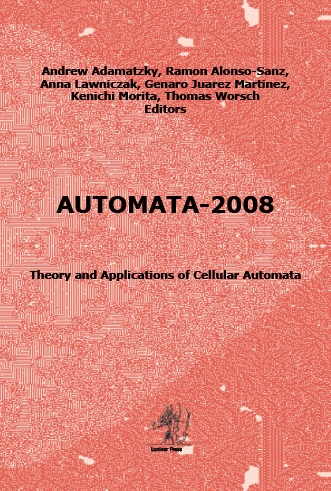
Hiroshi Umeo, Naoki Kamikawa, Jean-Baptiste Yunès
A family of smallest symmetrical four-state firing squad synchronization protocols for one-dimensional ring cellular automata Article de journal
Dans: p. 174–185, 2008, ISBN: 978-1-905986-16-5.
@article{umeo2008family,
title = {A family of smallest symmetrical four-state firing squad synchronization protocols for one-dimensional ring cellular automata},
author = {Hiroshi Umeo and Naoki Kamikawa and Jean-Baptiste Yunès},
editor = {Andrew Adamatsky and Ramon Alonso-Sanz and Anna Lawniczak and Genaro Juarez Martinez and Kenichi Morita and Thomas Worsch },
isbn = {978-1-905986-16-5},
year = {2008},
date = {2008-06-12},
booktitle = {Proceedings of AUTOMATA 2008. 14th International Workshop on Cellular Automata, Bristol, United Kingdom, September 2008. Theory and Applications of Cellular Automata.},
pages = {174--185},
publisher = {Luniver Press},
abstract = {An existence or non-existence of five-state firing squad synchronization protocol has been a longstanding and famous open problem for a long time. In this paper, we answer partially to this problem by proposing a family of smallest four-state firing squad synchronization protocols that can synchronize any one-dimensional ring cellular arrays of length n = 2^k for any positive integer k. The number four is the smallest one in the class of synchronization protocols proposed so far.},
keywords = {},
pubstate = {published},
tppubtype = {article}
}
An existence or non-existence of five-state firing squad synchronization protocol has been a longstanding and famous open problem for a long time. In this paper, we answer partially to this problem by proposing a family of smallest four-state firing squad synchronization protocols that can synchronize any one-dimensional ring cellular arrays of length n = 2^k for any positive integer k. The number four is the smallest one in the class of synchronization protocols proposed so far.
Olga Masnyk Hansen, Jean Francis Michon, Pierre Valarcher, Jean-Baptiste Yunès (Ed.)
BFCA 2008. Proceedings of BFCA’08, Fourth international workshop on Boolean Functions : Cryptography and Applications. May 19—21, 2008. IBM, Copenhagen, Denmark. Ouvrage
2008.
@book{bfca08,
title = {BFCA 2008. Proceedings of BFCA’08, Fourth international workshop on Boolean Functions : Cryptography and Applications. May 19—21, 2008. IBM, Copenhagen, Denmark.},
editor = {Olga Masnyk Hansen and Jean Francis Michon and Pierre Valarcher and Jean-Baptiste Yunès},
url = {https://yunes.informatique.univ-paris-diderot.fr/raw/bfca/bfca08/},
year = {2008},
date = {2008-05-21},
keywords = {},
pubstate = {published},
tppubtype = {book}
}
Jean-Baptiste Yunès
Goto's construction and Pascal's triangle: new insights into cellular automata synchronization Proceedings Article
Dans: Proceedings of the first symposium on cellular automata, "Journées Automates Cellulaires", JAC 2008, Uzès, France, 2008, p. 195–203, Издательство МЦНМО 2008, ISBN: 978-5-94057-377-7.
@inproceedings{yunes2008goto,
title = {Goto's construction and Pascal's triangle: new insights into cellular automata synchronization},
author = {Jean-Baptiste Yunès},
url = {https://yunes.informatique.univ-paris-diderot.fr/raw/publications/jac08/Jac.html},
isbn = {978-5-94057-377-7},
year = {2008},
date = {2008-05-01},
booktitle = {Proceedings of the first symposium on cellular automata, "Journées Automates Cellulaires", JAC 2008, Uzès, France, 2008},
pages = {195--203},
organization = {Издательство МЦНМО},
keywords = {},
pubstate = {published},
tppubtype = {inproceedings}
}
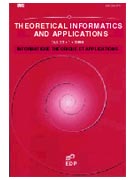
Jean-Baptiste Yunès
An intrinsically non minimal-time Minsky-like 6-states solution to the firing squad synchronization problem Article de journal
Dans: RAIRO - Theoretical Informatics and Applications, vol. 42, no. 1, p. 55–68, 2008.
@article{yunes2008intrinsically,
title = {An intrinsically non minimal-time Minsky-like 6-states solution to the firing squad synchronization problem},
author = {Jean-Baptiste Yunès},
doi = {10.1051/ita:2007051},
year = {2008},
date = {2008-01-18},
journal = {RAIRO - Theoretical Informatics and Applications},
volume = {42},
number = {1},
pages = {55--68},
publisher = {EDP Sciences},
abstract = {Here is presented a 6-states non minimal-time solution which is intrinsically Minsky-like and solves the three following problems: unrestricted version on a line, with one initiator at each end of a line and the problem on a ring. We also give a complete proof of correctness of our solution, which was never done in a publication for Minsky's solutions.},
keywords = {},
pubstate = {published},
tppubtype = {article}
}
Here is presented a 6-states non minimal-time solution which is intrinsically Minsky-like and solves the three following problems: unrestricted version on a line, with one initiator at each end of a line and the problem on a ring. We also give a complete proof of correctness of our solution, which was never done in a publication for Minsky's solutions.
2007
Jean-Baptiste Yunès
Automates Cellulaires; Fonctions Booléennes. Mémoire d'Habilitation à Diriger des Recherches Thèse
Université Paris Diderot, 2007.
@phdthesis{yunes2007automates,
title = {Automates Cellulaires; Fonctions Booléennes. Mémoire d'Habilitation à Diriger des Recherches},
author = {Jean-Baptiste Yunès},
url = {https://yunes.informatique.univ-paris-diderot.fr/raw/publicationsHDR.pdf},
year = {2007},
date = {2007-12-12},
school = {Université Paris Diderot},
keywords = {},
pubstate = {published},
tppubtype = {phdthesis}
}

Jean-Baptiste Yunès
Simple new algorithm which solve the FSSP: a 4n-steps 7-states solution Proceedings Article
Dans: International Conference on Machines, Computations, and Universality. MCU 2007: Machines, Computations, and Universality. Université d'Orléans, France, September 10—13, 2007., p. 316–324, Springer, Berlin, Heidelberg., 2007, ISBN: 978-3-540-74593-8.
@inproceedings{yunes2007simpleb,
title = {Simple new algorithm which solve the FSSP: a 4n-steps 7-states solution},
author = {Jean-Baptiste Yunès},
doi = {10.1007/978-3-540-74593-8_27},
isbn = {978-3-540-74593-8},
year = {2007},
date = {2007-09-10},
booktitle = {International Conference on Machines, Computations, and Universality. MCU 2007: Machines, Computations, and Universality. Université d'Orléans, France, September 10—13, 2007.},
pages = {316--324},
publisher = {Springer, Berlin, Heidelberg.},
abstract = {We present a new family of solutions to the firing squad synchronization problem. All these solutions are built with a few finite number of signals, which lead to simple implementations with 7 or 8 internal states. Using one of these schemes we are able to built a 7-states 4𝑛+O(log𝑛) -steps solution to the firing squad synchronization problem. These solutions not only solves the unrestricted problem (initiator at one of the two ends), but also the problem with initiators at both ends and the problem on a ring.},
keywords = {},
pubstate = {published},
tppubtype = {inproceedings}
}
We present a new family of solutions to the firing squad synchronization problem. All these solutions are built with a few finite number of signals, which lead to simple implementations with 7 or 8 internal states. Using one of these schemes we are able to built a 7-states 4𝑛+O(log𝑛) -steps solution to the firing squad synchronization problem. These solutions not only solves the unrestricted problem (initiator at one of the two ends), but also the problem with initiators at both ends and the problem on a ring.
Jean-Baptiste Yunès
New extensions to some firing squad synchronization solutions Proceedings Article
Dans: AUTOMATA 2007. 13th International Workshop on Cellular Automata, Fields Institute, Toronto, Canada, August 27—29, 2007. IFIP TC1 WG 1.5., 2007.
@inproceedings{yunes2007new,
title = {New extensions to some firing squad synchronization solutions},
author = {Jean-Baptiste Yunès},
year = {2007},
date = {2007-08-27},
booktitle = {AUTOMATA 2007. 13th International Workshop on Cellular Automata, Fields Institute, Toronto, Canada, August 27—29, 2007. IFIP TC1 WG 1.5.},
keywords = {},
pubstate = {published},
tppubtype = {inproceedings}
}
Jean-Baptiste Yunès
Revisiting existing solutions to the firing squad synchronization problem Proceedings Article
Dans: WSDC'07, Workshop on Symbolic Dynamic and Coding. Institut Gaspard Monge, Marne-la-Vallée, France, July 2—4, 2007., 2007.
@inproceedings{yunes2007revisiting,
title = {Revisiting existing solutions to the firing squad synchronization problem},
author = {Jean-Baptiste Yunès},
year = {2007},
date = {2007-07-02},
booktitle = {WSDC'07, Workshop on Symbolic Dynamic and Coding. Institut Gaspard Monge, Marne-la-Vallée, France, July 2—4, 2007.},
keywords = {},
pubstate = {published},
tppubtype = {inproceedings}
}
Jean-Francis Michon, Pierre Valarcher, Jean-Baptiste Yunès (Ed.)
BFCA 07. Proceedings of BFCA'07, Third international workshop on Boolean Functions : Cryptography and Applications. May 2—3, 2007. LIAFA, Université Paris Diderot, France. Ouvrage
2007.
@book{bfca07,
title = {BFCA 07. Proceedings of BFCA'07, Third international workshop on Boolean Functions : Cryptography and Applications. May 2—3, 2007. LIAFA, Université Paris Diderot, France.},
editor = {Jean-Francis Michon and Pierre Valarcher and Jean-Baptiste Yunès},
url = {https://yunes.informatique.univ-paris-diderot.fr/raw/bfca/bfca07/},
year = {2007},
date = {2007-05-03},
keywords = {},
pubstate = {published},
tppubtype = {book}
}
2006
Jean Francis Michon, Pierre Valarcher, Jean-Baptiste Yunès (Ed.)
BFCA 06. Proceedings of BFCA’06, Second international workshop on Boolean Functions : Cryptography and Applications. March 13—15, 2006. LIFAR, Université Rouen, France. Ouvrage
Presses Universitaires de Rouen et du Havre, 2006, ISBN: 978-2-87775-422-4.
@book{bfca06,
title = {BFCA 06. Proceedings of BFCA’06, Second international workshop on Boolean Functions : Cryptography and Applications. March 13—15, 2006. LIFAR, Université Rouen, France.},
editor = { Jean Francis Michon and Pierre Valarcher and Jean-Baptiste Yunès},
url = {https://yunes.informatique.univ-paris-diderot.fr/raw/bfca/bfca06/},
isbn = {978-2-87775-422-4},
year = {2006},
date = {2006-03-13},
publisher = { Presses Universitaires de Rouen et du Havre},
keywords = {},
pubstate = {published},
tppubtype = {book}
}

Jean-Baptiste Yunès
Fault Tolerant Solutions to the Firing Squad Synchronization Problem in Linear Cellular Automata. Article de journal
Dans: J. Cellular Automata, vol. 1, no. 3, p. 253–268, 2006.
@article{yunes2006fault,
title = {Fault Tolerant Solutions to the Firing Squad Synchronization Problem in Linear Cellular Automata.},
author = {Jean-Baptiste Yunès},
url = {https://www.oldcitypublishing.com/journals/jca-home/jca-issue-contents/jca-volume-1-number-3-2006/jca-1-3-p-253-268/},
year = {2006},
date = {2006-01-01},
journal = {J. Cellular Automata},
volume = {1},
number = {3},
pages = {253--268},
abstract = {We consider some specific instances of the firing squad synchronization problem in which some cells are possibly defectives. As Umeo [16] showed, minimal-time solutions exist in the case there are locally more working cells than defective ones. This paper explains how to set up different schemes to obtain a linear-time synchronization on defective lines in the case there are locally more defective cells than working ones (but globally not too much many ones).},
keywords = {},
pubstate = {published},
tppubtype = {article}
}
We consider some specific instances of the firing squad synchronization problem in which some cells are possibly defectives. As Umeo [16] showed, minimal-time solutions exist in the case there are locally more working cells than defective ones. This paper explains how to set up different schemes to obtain a linear-time synchronization on defective lines in the case there are locally more defective cells than working ones (but globally not too much many ones).
2005

Jean-Francis Michon, Jean-Baptiste Yunès, Pierre Valarcher
On maximal QROBDD's of Boolean functions Article de journal
Dans: RAIRO - Theoretical Informatics and Applications, vol. 39, no. 4, p. 677–686, 2005.
@article{michon2005maximal,
title = {On maximal QROBDD's of Boolean functions},
author = {Jean-Francis Michon and Jean-Baptiste Yunès and Pierre Valarcher},
doi = {10.1051/ita:2005036},
year = {2005},
date = {2005-01-01},
journal = {RAIRO - Theoretical Informatics and Applications},
volume = {39},
number = {4},
pages = {677--686},
publisher = {EDP Sciences},
abstract = {We investigate the structure of “worst-case” quasi reduced ordered decision diagrams and Boolean functions whose truth tables are associated to: we suggest different ways to count and enumerate them. We, then, introduce a notion of complexity which leads to the concept of “hard” Boolean functions as functions whose QROBDD are “worst-case” ones. So we exhibit the relation between hard functions and the Storage Access function (also known as Multiplexer).},
keywords = {},
pubstate = {published},
tppubtype = {article}
}
We investigate the structure of “worst-case” quasi reduced ordered decision diagrams and Boolean functions whose truth tables are associated to: we suggest different ways to count and enumerate them. We, then, introduce a notion of complexity which leads to the concept of “hard” Boolean functions as functions whose QROBDD are “worst-case” ones. So we exhibit the relation between hard functions and the Storage Access function (also known as Multiplexer).
Jean-Baptiste Yunès, Pierre Valarcher, Jean-Francis Michon
BFCA 05. Proceedings of BFCA’05, First international workshop on Boolean Functions : Cryptography and Applications. March 7—8, 2005. LIFAR, Université Rouen, France. Ouvrage
Presses Universitaires de Rouen et du Havre, 2005, ISBN: 2-87775-403-0.
@book{yunes2005bfca,
title = {BFCA 05. Proceedings of BFCA’05, First international workshop on Boolean Functions : Cryptography and Applications. March 7—8, 2005. LIFAR, Université Rouen, France.},
author = {Jean-Baptiste Yunès and Pierre Valarcher and Jean-Francis Michon},
url = {https://yunes.informatique.univ-paris-diderot.fr/raw/bfca/bfca05/},
isbn = {2-87775-403-0},
year = {2005},
date = {2005-01-01},
publisher = {Presses Universitaires de Rouen et du Havre},
keywords = {},
pubstate = {published},
tppubtype = {book}
}
2004

Jean-Francis Michon, Pierre Valarcher, Jean-Baptiste Yunès
HFE and BDDs: A practical attempt at cryptanalysis Book Section
Dans: K.Q. Feng, H. Niederreiter, C.P. Xing (Ed.): Proceedings of CCC'03, Coding, Cryptography and Combinatorics. Progress in Computer Science and Applied Logic., p. 237–246, Birkhäuser, Basel, 2004, ISBN: 978-3-7643-2429-5.
@incollection{michon2004hfe,
title = {HFE and BDDs: A practical attempt at cryptanalysis},
author = {Jean-Francis Michon and Pierre Valarcher and Jean-Baptiste Yunès},
editor = {K.Q. Feng and H. Niederreiter and C.P. Xing},
doi = {10.1007/978-3-0348-7865-4_16},
isbn = {978-3-7643-2429-5},
year = {2004},
date = {2004-01-01},
booktitle = {Proceedings of CCC'03, Coding, Cryptography and Combinatorics. Progress in Computer Science and Applied Logic.},
pages = {237--246},
publisher = {Birkhäuser, Basel},
abstract = {HFE (Hidden Field Equations) is a public key cryptosystem using univariate polynomials over finite fields. It was proposed by J. Patarin in 1996. Well chosen parameters during the construction produce a system of quadratic multivariate polynomials over 𝔽2 as the public key. An enclosed trapdoor is used to decrypt messages. We propose a ciphertext-only attack which mainly consists in satisfying a boolean formula. Our algorithm is based on BDDs (Binary Decision Diagrams), introduced by Bryant in 1986, which allow to represent and manipulate, possibly efficiently, boolean functions. This paper is devoted to some experimental results we obtained while trying to solve the Patarin’s challenge. This approach was not successful, nevertheless it provided some interesting information about the security of HFE cryptosystem.},
keywords = {},
pubstate = {published},
tppubtype = {incollection}
}
HFE (Hidden Field Equations) is a public key cryptosystem using univariate polynomials over finite fields. It was proposed by J. Patarin in 1996. Well chosen parameters during the construction produce a system of quadratic multivariate polynomials over 𝔽2 as the public key. An enclosed trapdoor is used to decrypt messages. We propose a ciphertext-only attack which mainly consists in satisfying a boolean formula. Our algorithm is based on BDDs (Binary Decision Diagrams), introduced by Bryant in 1986, which allow to represent and manipulate, possibly efficiently, boolean functions. This paper is devoted to some experimental results we obtained while trying to solve the Patarin’s challenge. This approach was not successful, nevertheless it provided some interesting information about the security of HFE cryptosystem.
Jean-Baptiste Yunès, Jean-Francis Michon, Pierre Valarcher
A100344, Sequence of Enumeration of QROBDD Article de journal
Dans: The Online Encyclopedia of Integer Sequences, 2004.
@article{yunes2004sequence,
title = {A100344, Sequence of Enumeration of QROBDD},
author = {Jean-Baptiste Yunès and Jean-Francis Michon and Pierre Valarcher},
url = {http://oeis.org/A100344},
year = {2004},
date = {2004-01-01},
journal = {The Online Encyclopedia of Integer Sequences},
abstract = {Gives the i-th coefficient M(k,i) of the decomposition of the polynomials B(k,X^2) in the basis of all B(i,X), where B(i,X) is the i-th binomial polynomial: B(i,X) = X(X-1)...(X-i+1)/i! for any i > 0 and B(0,X) = 1 by definition.},
keywords = {},
pubstate = {published},
tppubtype = {article}
}
Gives the i-th coefficient M(k,i) of the decomposition of the polynomials B(k,X^2) in the basis of all B(i,X), where B(i,X) is the i-th binomial polynomial: B(i,X) = X(X-1)...(X-i+1)/i! for any i > 0 and B(0,X) = 1 by definition.
2003
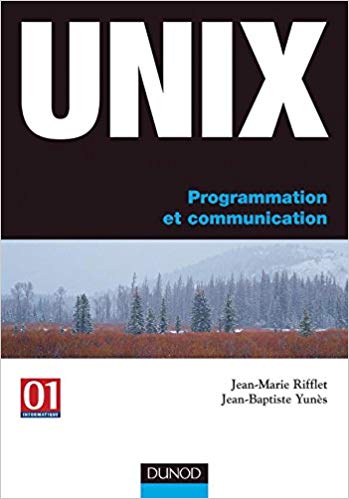
Jean-Marie Rifflet, Jean-Baptiste Yunès
Unix: Programmation et Communication Ouvrage
Dunod, 2003, ISBN: 978-2100079667.
@book{yunes2003unix,
title = {Unix: Programmation et Communication},
author = {Jean-Marie Rifflet and Jean-Baptiste Yunès},
url = {https://www.dunod.com/sciences-techniques/unix-programmation-et-communication},
isbn = {978-2100079667},
year = {2003},
date = {2003-08-21},
publisher = {Dunod},
abstract = {Prise en main. Le système de gestion de fichiers. Les processus. Les principales commandes du système. Les langages de commande. L'édition de textes. Les interfaces graphiques. Le langage C. Les outils de développement. Généralités sur l'interface avec le système. Les entrées-sorties. Terminaux, groupes et sessions. La gestion des processus. La gestion des signaux. La communication par tubes. IPC System V et IPC Posix. Les threads. Unix et réseaux. RPC. Sockets.},
keywords = {},
pubstate = {published},
tppubtype = {book}
}
Prise en main. Le système de gestion de fichiers. Les processus. Les principales commandes du système. Les langages de commande. L'édition de textes. Les interfaces graphiques. Le langage C. Les outils de développement. Généralités sur l'interface avec le système. Les entrées-sorties. Terminaux, groupes et sessions. La gestion des processus. La gestion des signaux. La communication par tubes. IPC System V et IPC Posix. Les threads. Unix et réseaux. RPC. Sockets.
2002
Jean-Francis Michon, Jean-Baptiste Yunes, Pierre Valarcher
Attaque du système HFE par BDD Rapport technique
2002.
@techreport{michonand,
title = {Attaque du système HFE par BDD},
author = {Jean-Francis Michon and Jean-Baptiste Yunes and Pierre Valarcher},
url = {https://yunes.informatique.univ-paris-diderot.fr/raw/publications/HFE.pdf},
year = {2002},
date = {2002-01-01},
keywords = {},
pubstate = {published},
tppubtype = {techreport}
}
1999
Jean-Baptiste Yunès
An Implementation of a Fault Tolerant Scheme of the FSSP Proceedings Article
Dans: Automata 1999, IFIP WG1.5 Meeting, École Normale Supérieure de Lyon, Lyon, France., 1999.
@inproceedings{yunes1999implementation,
title = {An Implementation of a Fault Tolerant Scheme of the FSSP},
author = {Jean-Baptiste Yunès},
year = {1999},
date = {1999-01-01},
booktitle = {Automata 1999, IFIP WG1.5 Meeting, École Normale Supérieure de Lyon, Lyon, France.},
keywords = {},
pubstate = {published},
tppubtype = {inproceedings}
}
1997
Debra Cameron, Bill Rosenblatt, Jean-Baptiste Yunès (traducteur)
Introduction à GNU Emacs Ouvrage
O'Reilly, 1997, ISBN: 2-84177-015-X.
@book{emacs,
title = {Introduction à GNU Emacs},
author = {Debra Cameron and Bill Rosenblatt and Jean-Baptiste Yunès (traducteur)},
url = {https://www.eyrolles.com/Informatique/Livre/introduction-a-gnu-emacs-9782841770151/},
isbn = {2-84177-015-X},
year = {1997},
date = {1997-01-01},
publisher = {O'Reilly},
keywords = {},
pubstate = {published},
tppubtype = {book}
}
1996
Cricket Liu, Jerry Peek, Russ Jones, Bryan Buus, Adrian Nye, Gauthier Groult (traducteur), Jean-Baptiste Yunès (traducteur)
Systèmes d’information sur Internet: Installation et mise en oeuvre Ouvrage
O'Reilly, 1996, ISBN: 2-84177-013-3.
@book{internet,
title = {Systèmes d’information sur Internet: Installation et mise en oeuvre},
author = {Cricket Liu and Jerry Peek and Russ Jones and Bryan Buus and Adrian Nye and Gauthier Groult (traducteur) and Jean-Baptiste Yunès (traducteur)},
isbn = {2-84177-013-3},
year = {1996},
date = {1996-01-01},
publisher = {O'Reilly},
keywords = {},
pubstate = {published},
tppubtype = {book}
}
1995
Jean-Baptiste Yunès
Solutions Tolérantes aux pannes pour le problème de la synchronisation d'une ligne de fusiliers. Proceedings Article
Dans: ASMICS Workshop, Roanne, France., 1995.
@inproceedings{yunes1995solutions,
title = {Solutions Tolérantes aux pannes pour le problème de la synchronisation d'une ligne de fusiliers.},
author = {Jean-Baptiste Yunès},
url = {https://yunes.informatique.univ-paris-diderot.fr/raw/publications/roanne.pdf},
year = {1995},
date = {1995-01-01},
booktitle = {ASMICS Workshop, Roanne, France.},
keywords = {},
pubstate = {published},
tppubtype = {inproceedings}
}
Jean-Baptiste Yunès
Fault tolerant solutions to the firing squad synchronization problem Proceedings Article
Dans: Jozef Gruska, Hiroshi Umeo, Roland Vollmar (Ed.): Dagstuhl Seminar Report. Automata 1995, Schloss Dagstuhl 9510, Dagstuhl, Germany., p. 28, Dagstuhl 1995.
@inproceedings{yunes1995fault,
title = {Fault tolerant solutions to the firing squad synchronization problem},
author = {Jean-Baptiste Yunès},
editor = {Jozef Gruska and Hiroshi Umeo and Roland Vollmar},
url = {https://yunes.informatique.univ-paris-diderot.fr/raw/publications/dagstuhl.pdf},
year = {1995},
date = {1995-01-01},
booktitle = {Dagstuhl Seminar Report. Automata 1995, Schloss Dagstuhl 9510, Dagstuhl, Germany.},
pages = {28},
organization = {Dagstuhl},
keywords = {},
pubstate = {published},
tppubtype = {inproceedings}
}
73 Entrées « ‹ 1 de 2
› » Direction
2013

David Ameisen
Intégration des lames virtuelles dans le dossier patient électronique Thèse
LIAFA, Université Paris Diderot, 2013.
@phdthesis{ameisene,
title = {Intégration des lames virtuelles dans le dossier patient électronique},
author = {David Ameisen},
url = {http://www.theses.fr/2013PA077010#},
year = {2013},
date = {2013-03-29},
school = {LIAFA, Université Paris Diderot},
abstract = {Les avancées technologiques dans le domaine de l'informatique médicale ainsi que l'augmentation systématique du volume d'information produit engendrent des questions de changement d'échelle et d'interopérabilité des nouveaux matériels, en particulier en imagerie, avec les systèmes d'information de santé. Il en résulte actuellement un manque de diversité d'images numériques sur lesquelles baser un avis médical ou en demander un second, sur place ou à distance. Nous avons ainsi conçu, développé et mis en production une plateforme web de mise en commun d'images médicales en rendant interopérable les systèmes d'acquisition et de restitution d'images normalisés et non normalisés avec les serveurs hospitaliers hébergeant les données patient. Cette plateforme donne accès à plus de 50000 documents multimédia tels que des rapports contenant du texte et des images, des images usuelles ou encore des images composées de plusieurs milliards de pixels : les lames virtuelles. Au cours de la réalisation de ces travaux, nous avons entrepris de formaliser l'appréciation visuelle de la qualité d'une image numérique et d'une lame virtuelle en élaborant des algorithmes proches de l'appréciation visuelle et plus rapide que les existants pour détecter le degré de flou présent dans les images numériques. Nous avons ensuiti développé des outils d'estimation en temps quasi-réel du flou comme premier indicateur pour l'analyse générale de la qualité des lames virtuelles pour les usages cliniques, pédagogiques et en recherche. Deux demandes de brevets, dont une en PCT, ainsi qu'une publication résultent de ces travaux, avec en perspective de nombreuses applications en imagerie généraliste et médicale.},
keywords = {},
pubstate = {published},
tppubtype = {phdthesis}
}
Les avancées technologiques dans le domaine de l'informatique médicale ainsi que l'augmentation systématique du volume d'information produit engendrent des questions de changement d'échelle et d'interopérabilité des nouveaux matériels, en particulier en imagerie, avec les systèmes d'information de santé. Il en résulte actuellement un manque de diversité d'images numériques sur lesquelles baser un avis médical ou en demander un second, sur place ou à distance. Nous avons ainsi conçu, développé et mis en production une plateforme web de mise en commun d'images médicales en rendant interopérable les systèmes d'acquisition et de restitution d'images normalisés et non normalisés avec les serveurs hospitaliers hébergeant les données patient. Cette plateforme donne accès à plus de 50000 documents multimédia tels que des rapports contenant du texte et des images, des images usuelles ou encore des images composées de plusieurs milliards de pixels : les lames virtuelles. Au cours de la réalisation de ces travaux, nous avons entrepris de formaliser l'appréciation visuelle de la qualité d'une image numérique et d'une lame virtuelle en élaborant des algorithmes proches de l'appréciation visuelle et plus rapide que les existants pour détecter le degré de flou présent dans les images numériques. Nous avons ensuiti développé des outils d'estimation en temps quasi-réel du flou comme premier indicateur pour l'analyse générale de la qualité des lames virtuelles pour les usages cliniques, pédagogiques et en recherche. Deux demandes de brevets, dont une en PCT, ainsi qu'une publication résultent de ces travaux, avec en perspective de nombreuses applications en imagerie généraliste et médicale.
Jury
2021
Jury de thèse de Piotr Krasnowski (Directeur Bruno Martin)
Joint source-cryptographic-channel coding for real-time secure voice communications on voice channels Thèse
Université Côte-d'Azur, 2021.
@phdthesis{Krasnowski2021,
title = {Joint source-cryptographic-channel coding for real-time secure voice communications on voice channels},
author = {Jury de thèse de Piotr Krasnowski (Directeur Bruno Martin)},
year = {2021},
date = {2021-05-27},
school = {Université Côte-d'Azur},
keywords = {},
pubstate = {published},
tppubtype = {phdthesis}
}
2018
Jury de Thèse de Tom Besson (Directeur Jérôme Durand-Lose)
Discrétisation automatique de machines à signaux en automates cellulaires. Thèse
LIFO, Université d'Orléans, 2018.
@phdthesis{besson,
title = {Discrétisation automatique de machines à signaux en automates cellulaires.},
author = {Jury de Thèse de Tom Besson (Directeur Jérôme Durand-Lose)},
year = {2018},
date = {2018-04-10},
school = {LIFO, Université d'Orléans},
abstract = {Dans le contexte du calcul géométrique abstrait, les machines à signaux ont été développées comme le pendant continu des automates cellulaires capturant les notions de particules, de signaux et de collisions. Une question importante est la génération automatique d’un automate cellulaire reproduisant la dynamique d’une machine à signaux donnée. D’une part, il existe des conversions ad hoc. D’autre part, ce n’est pas toujours possible car certaines machines à signaux présentent des comportements « continus ». Par conséquent, la discrétisation automatique de telles structures est souvent complexe et pas toujours possible. Cette thèse propose trois manières différentes de discrétiser automatiquement les machines à signaux en automates cellulaires, avec ou sans approximation possible. La première s’intéresse à une sous-catégorie de machines à signaux, qui présente des propriétés permettant d’assurer une discrétisation automatique exacte pour toute machine de ce type. La deuxième est utilisable sur toutes les machines mais ne peut assurer ni l’exactitude ni la correction du résultat. La troisième s’appuie sur une nouvelle expression de la dynamique d’une machine à signaux pour proposer une discrétisation. Cette expression porte le nom de modularité et est décrite avant d’être utilisée pour discrétiser.},
keywords = {},
pubstate = {published},
tppubtype = {phdthesis}
}
Dans le contexte du calcul géométrique abstrait, les machines à signaux ont été développées comme le pendant continu des automates cellulaires capturant les notions de particules, de signaux et de collisions. Une question importante est la génération automatique d’un automate cellulaire reproduisant la dynamique d’une machine à signaux donnée. D’une part, il existe des conversions ad hoc. D’autre part, ce n’est pas toujours possible car certaines machines à signaux présentent des comportements « continus ». Par conséquent, la discrétisation automatique de telles structures est souvent complexe et pas toujours possible. Cette thèse propose trois manières différentes de discrétiser automatiquement les machines à signaux en automates cellulaires, avec ou sans approximation possible. La première s’intéresse à une sous-catégorie de machines à signaux, qui présente des propriétés permettant d’assurer une discrétisation automatique exacte pour toute machine de ce type. La deuxième est utilisable sur toutes les machines mais ne peut assurer ni l’exactitude ni la correction du résultat. La troisième s’appuie sur une nouvelle expression de la dynamique d’une machine à signaux pour proposer une discrétisation. Cette expression porte le nom de modularité et est décrite avant d’être utilisée pour discrétiser.
2013
Rapporteur et Jury de thèse de Maxime Senot (Directeur Jérôme Durand-Lose)
Modèle géométrique de calcul : fractales et barrières de complexité Thèse
LIFO, Université d'Orléans, 2013.
@phdthesis{senot,
title = {Modèle géométrique de calcul : fractales et barrières de complexité},
author = {Rapporteur et Jury de thèse de Maxime Senot (Directeur Jérôme Durand-Lose)},
url = {https://tel.archives-ouvertes.fr/file/index/docid/870600/filename/these.pdf},
year = {2013},
date = {2013-10-07},
school = {LIFO, Université d'Orléans},
keywords = {},
pubstate = {published},
tppubtype = {phdthesis}
}
2012
Rapporteur et membre du jury d'Habilitation à Diriger des Recherches de Christophe Prieur
La conjuration des égos. Réseaux, algorithmes, identités Thèse
LIAFA, Université Paris Diderot, 2012.
@phdthesis{prieur,
title = {La conjuration des égos. Réseaux, algorithmes, identités},
author = {Rapporteur et membre du jury d'Habilitation à Diriger des Recherches de Christophe Prieur},
year = {2012},
date = {2012-11-30},
school = {LIAFA, Université Paris Diderot},
keywords = {},
pubstate = {published},
tppubtype = {phdthesis}
}
2011
Jury de l'Habilitation à Diriger des Recherches de Véronique Terrier
Reconnaissance de langages par automates cellulaires Thèse
GREYC, Université de Caen, 2011.
@phdthesis{terrier,
title = {Reconnaissance de langages par automates cellulaires},
author = {Jury de l'Habilitation à Diriger des Recherches de Véronique Terrier},
url = {https://tel.archives-ouvertes.fr/tel-01070916/document},
year = {2011},
date = {2011-01-01},
school = {GREYC, Université de Caen},
keywords = {},
pubstate = {published},
tppubtype = {phdthesis}
}
2010
Jury de Thèse de Luidnel Maignan (Directeur Frédéric Gruau)
Algorithmique distribuée pour la programmation des milieux de calcul Thèse
LRI, Université Paris 11, 2010.
@phdthesis{maignan2016fieldb,
title = {Algorithmique distribuée pour la programmation des milieux de calcul},
author = {Jury de Thèse de Luidnel Maignan (Directeur Frédéric Gruau)},
year = {2010},
date = {2010-12-01},
school = {LRI, Université Paris 11},
keywords = {},
pubstate = {published},
tppubtype = {phdthesis}
}
2005
Jury de thèse de Benoît Poulot-Cazajous (Directeur Jean-Marie Rifflet)
Méthodes et outils pour la production de systèmes d'exploitation : application à ChorusOS Thèse
LIAFA, Université Paris Diderot, 2005.
@phdthesis{poulot,
title = {Méthodes et outils pour la production de systèmes d'exploitation : application à ChorusOS},
author = {Jury de thèse de Benoît Poulot-Cazajous (Directeur Jean-Marie Rifflet)},
year = {2005},
date = {2005-01-01},
school = {LIAFA, Université Paris Diderot},
keywords = {},
pubstate = {published},
tppubtype = {phdthesis}
}
2002
Jury de thèse de Yaël Haddad (Directeur Christian Choffrut)
Propriétés structurelles de certaines fonctions Booléeennes Thèse
LIAFA, Université Paris Diderot, 2002.
@phdthesis{haddad,
title = {Propriétés structurelles de certaines fonctions Booléeennes},
author = {Jury de thèse de Yaël Haddad (Directeur Christian Choffrut)},
url = {https://www.theses.fr/2002PA077242},
year = {2002},
date = {2002-01-01},
school = {LIAFA, Université Paris Diderot},
keywords = {},
pubstate = {published},
tppubtype = {phdthesis}
}
Organisation d’évènements
Conférences et du genre
- 2015. Journées ANR TARMAC and Spatial Computing
Fred Gruau, Luidnel Maignan, Jean-Baptiste Yunès. - 2011. Workshop on Sand Pile Model. April 7—8, 2011,
LIAFA, Paris, France.
Roberto Mantaci, Paulo Massazza, Jean-Baptiste Yunès - 2008. Rencontre: programmation sur automates cellulaires.
LIAFA, Paris, France. 6 Juin 2008.
Éric Thierry, Jean-Baptiste Yunès - 2008. BFCA’08 — Boolean Functions: Cryptography and Applications. May 19—21, 2008, Copenhagen, Denmark.
Olga Masnyk-Hansen, Jean-Francis Michon, Pierre Valarcher, Jean-Baptiste Yunès - 2008. Journée en l’honneur de Serge Grigorieff,
LIAFA, Paris, France. 15 Janvier 2008.
Patrick Cégielski, Christian Choffrut, Loïc Colson, Pierre Valarcher, Jean-Baptiste Yunès - 2007. BFCA’07, Boolean Functions: Cryptography and Applications. LIAFA, Université Paris Diderot, Paris, France. May 2—3, 2007.
Jean-Francis Michon, Pierre Valarcher, Jean-Baptiste Yunès - 2006. BFCA’06, Boolean Functions: Cryptography and Applications.
Université de Rouen, March 13—15, 2006.
Jean Francis Michon, Pierre Valarcher, Jean-Baptiste Yunès - 2005. BFCA’05, Boolean Functions: Cryptography and Applications.
Université de Rouen, March 7—8, 2005.
Jean Francis Michon, Pierre Valarcher, Jean-Baptiste Yunès
Concours
- 2009— : Co-organisateur des Journées Francilliennes de Programmation. Concours de programmation inter-universitaire conçu pour les étudiants de Licence. Logistique, organisation, conception tournante : Paris-Sud, Pierre et Marie Curie, Paris Diderot.
Charges particulières
- 2008—2010 : Chargé de mission TICE pour l’Université Paris Diderot.
- Édition du GUN
- Montage d’un prêt d’ordinateur portables
- Équipement de salles et amphis
- Installation de systèmes d’enregistrement
- Projet de vidéothèque
- Salles numériques
Éditeur
Membre du comité éditorial de la revue Journal of Celllular Automata.
Projets
2021
Jean-Baptiste Yunès, UFR d'Informatique and
Nicolas Ballier, UFR d'Études Anglophones Paris Diderot. and
Guillaume Wisniewski (UFR de linguistique)
IREEL - IDEEL Initiation interdisciplinaire au DEEp Learning Divers
2021.
@misc{nokey,
title = {IREEL - IDEEL Initiation interdisciplinaire au DEEp Learning},
author = {Jean-Baptiste Yunès, UFR d'Informatique and
Nicolas Ballier, UFR d'Études Anglophones Paris Diderot. and
Guillaume Wisniewski (UFR de linguistique)},
editor = {Université de Paris ANR-18-IDEX-0001 (vague 2)},
url = {https://yunes.informatique.univ-paris-diderot.fr/accueil/enseignement/ireel-relia/ireel-ideel-2021-2022/},
year = {2021},
date = {2021-09-01},
urldate = {2021-09-01},
keywords = {},
pubstate = {published},
tppubtype = {misc}
}
Financement : AAP Plateforme U-Paris
PAPTAN Divers
2021.
@misc{paptan,
title = {PAPTAN},
author = {Financement : AAP Plateforme U-Paris},
url = {https://www.clillac-arp.univ-paris-diderot.fr/projets/paptan},
year = {2021},
date = {2021-01-01},
urldate = {2021-01-01},
keywords = {},
pubstate = {published},
tppubtype = {misc}
}
Financement : DiiP (Ed.)
ComplexNeuroviz Divers
2021.
@misc{nokey,
title = {ComplexNeuroviz},
editor = {Financement : DiiP},
url = {https://www.clillac-arp.univ-paris-diderot.fr/projets/complexneuroviz},
year = {2021},
date = {2021-01-01},
urldate = {2021-01-01},
keywords = {},
pubstate = {published},
tppubtype = {misc}
}
2020
Nicolas Ballier (Porteur), CLILLAC-ARP, Université de Paris.
Mohamed Nadif (Co-porteur), LIPADE, Université de Paris.
Jean-Baptiste Yunès (Co-Porteur), IRIF, Université de Paris.
SPEcialised Corpora and neural TRANSlation (SPECTRANS). Divers
Appel à Projet « Émergence en Recherche » 2020 de l'Université de Paris., 2020.
@misc{spectrans2020,
title = {SPEcialised Corpora and neural TRANSlation (SPECTRANS).},
author = {Nicolas Ballier (Porteur), CLILLAC-ARP, Université de Paris.
Mohamed Nadif (Co-porteur), LIPADE, Université de Paris.
Jean-Baptiste Yunès (Co-Porteur), IRIF, Université de Paris.},
editor = {IDEX 2020.},
url = {https://u-paris.fr/appel-emergence-en-recherche-2020/
https://u-paris.fr/wp-content/uploads/2020/03/Lauréats_AAPEmergence2020.pdf},
year = {2020},
date = {2020-01-01},
howpublished = {Appel à Projet « Émergence en Recherche » 2020 de l'Université de Paris.},
keywords = {},
pubstate = {published},
tppubtype = {misc}
}
Guillaume Wisniewski, Université de Paris (Porteur), LLF.
Nicolas Ballier, Université de Paris, CLILLAC-ARP.
Jean-Baptiste Yunès, Université de Paris, IRIF.
Explorations et visualisations d’un système de traduction neuronale (NeuroViz) Divers
2020.
@misc{NeuroViz2020,
title = {Explorations et visualisations d’un système de traduction neuronale (NeuroViz)},
author = {Guillaume Wisniewski, Université de Paris (Porteur), LLF.
Nicolas Ballier, Université de Paris, CLILLAC-ARP.
Jean-Baptiste Yunès, Université de Paris, IRIF.},
editor = {DIM RFSI},
year = {2020},
date = {2020-01-01},
abstract = {Ce projet se propose de mieux comprendre le fonctionnement des réseaux de neurones appliqués à des données linguistiques, en particulier pour la traduction neuronale. Associant quatre laboratoires franciliens, deux en informatique et deux en linguistique, ce projet ne se cantonnera pas à une comparaison quantitative de systèmes de traduction (p.ex. par des scores BLEU) mais a pour objectif d'analyser de manière qualitative les effets de structures linguistiques et des représentations neuronales sur la qualité des traductions prédites.},
keywords = {},
pubstate = {published},
tppubtype = {misc}
}
Ce projet se propose de mieux comprendre le fonctionnement des réseaux de neurones appliqués à des données linguistiques, en particulier pour la traduction neuronale. Associant quatre laboratoires franciliens, deux en informatique et deux en linguistique, ce projet ne se cantonnera pas à une comparaison quantitative de systèmes de traduction (p.ex. par des scores BLEU) mais a pour objectif d'analyser de manière qualitative les effets de structures linguistiques et des représentations neuronales sur la qualité des traductions prédites.
Financement : AAP IDEX Émergence (Ed.)
SPECTRANS Divers
2020.
@misc{nokey,
title = {SPECTRANS},
editor = {Financement : AAP IDEX Émergence},
url = {https://www.clillac-arp.univ-paris-diderot.fr/projets/spectrans},
year = {2020},
date = {2020-01-01},
keywords = {},
pubstate = {published},
tppubtype = {misc}
}
Financement : Région (DIM RFSI 2020 - Réseau Francilien des Sciences Informatique) (Ed.)
Neuroviz Divers
2020.
@misc{nokey,
title = {Neuroviz},
editor = {Financement : Région (DIM RFSI 2020 - Réseau Francilien des Sciences Informatique)},
url = {https://github.com/neuroviz/},
year = {2020},
date = {2020-01-01},
keywords = {},
pubstate = {published},
tppubtype = {misc}
}
2019
Olivier Martin (porteur), CERLIS, Campus Descartes
Jean-Baptiste Yunès, UFR d'Informatique Paris Diderot.
Apprendre par la bande. Divers
2019.
@misc{bande2019,
title = {Apprendre par la bande.},
author = {Olivier Martin (porteur), CERLIS, Campus Descartes
Jean-Baptiste Yunès, UFR d'Informatique Paris Diderot.},
editor = {Idex 2019.},
url = {https://u-paris.fr/appel-initiatives-interdisciplinaires/},
year = {2019},
date = {2019-01-01},
abstract = {Appel à Projet « Émergence en Recherche - Initiatives Interdisciplinaires » 2019—2020 de l'Université de Paris.
Informatique/Sociologie.},
keywords = {},
pubstate = {published},
tppubtype = {misc}
}
Appel à Projet « Émergence en Recherche - Initiatives Interdisciplinaires » 2019—2020 de l'Université de Paris.
Informatique/Sociologie.
Jean-Baptiste Yunès, UFR d'Informatique
Nicolas Ballier, UFR d'Études Anglophones Paris Diderot.
IREEL - RELIA : Recherche En Licence Informatique et études Anglophones Divers
2019.
@misc{relia2019,
title = {IREEL - RELIA : Recherche En Licence Informatique et études Anglophones},
author = {Jean-Baptiste Yunès, UFR d'Informatique
Nicolas Ballier, UFR d'Études Anglophones Paris Diderot.},
editor = {Université de Paris ANR-18-IDEX-0001},
url = {https://u-paris.fr/appel-ireel-initiation-a-la-recherche-en-licence/
https://github.com/nballier/RELIA
https://yunes.informatique.univ-paris-diderot.fr/accueil/enseignement/ireel-relia/},
year = {2019},
date = {2019-01-01},
urldate = {2019-01-01},
keywords = {},
pubstate = {published},
tppubtype = {misc}
}
- 2014 : 2027 – la salle interactive
AAP Pédagogies Innovantes – USPC Université Sorbonne Paris Cité – 2014.
Jean-Baptiste Yunès (conception), François Laroussinie (pilotage)
Présentation le 9 Juin 2016 dans le cadre de la journée «pédagogie innovante» organisée par l’USPC.
Vidéo, vidéo, FLEXSpace, web - 2012—2017 : ANR TARMAC : Theory of AlgoRithm, Machines, completeness, Axiomatization and physical Constraints.
ANR-12-BS02-0007.
Jean-Baptiste Yunès (Task #2 – leader, LIAFA team – team leader)
Web - 2012—2015 : FUI FlexMIM : Plate-forme de partage et gestion d’images médicales de grandes dimensions permettant le télédiagnostic.
14ième appel à projet FUI (Fonds Unique Interministériel), 2012-2015. Projet labellisé par Medicen et Systematic.
David Ameisen, Philippe Bertheau, Jean-Baptiste Yunès (WP3, WP4) - 2012—2013 : IFADEM/OIF/AUF/UNESCO
- 2013. MINES-DGESIP Ministère de l’Enseignement Supérieur et de la Recherche
Rachid El Boussarghini, Vincenzo Musco, Patrick Pollet, Jean-Baptiste Yunès.
« Développement de services orientés enseignant pour une application dédiée au C2I (Certificat Informatique et Internet) basée sur les technologies HTML5. » - 2013. IFADEM (OIF – AUF)
Vincent Bellenger, Papa Youga Dieng, Rachid El Boussarghini, Baptiste Fontaine, Jean-Baptiste Yunès.
« Développement d’une application de mise à disposition de ressources pédagogiques sur terminaux mobiles pour enseignants IFADEM. »
Travail ayant donné lieu à une communication à l’UNESCO de Papa Youga Dieng (coordinateur IFADEM). - 2012. MINES-DGESIP Ministère de l’Enseignement Supérieur et de la Recherche
Rachid El Boussarghini, Thierry Koscielniak, François Lankar, Vincenzo Musco, Patrick Pollet, Jean-Baptiste Yunès.
« Développement d’une application dédiée au C2I (Certificat Informatique et Internet) basée sur les technologies HTML5. »
- 2011 : Robothétie. Appel à projets pédagogiques émergents du PRES Sorbonne Paris Cité, 2011. Projet Inter-établissement
Yann Régis-Gianas, Jean-Baptiste Yunès (porteurs Université Paris Diderot).- Concours de robot.
- Communication : Yann Régis-Gianas, Jean-Baptiste Yunès. « Robothétie : une expérience pédagogique en 2012.
FB, document
- 2002—2006 : Membre ACI Cryptologie
- 1994—2000? : Membre ACI ??
Non classé
2022. Enseignant/Chercheur invité. Invited professor.
École d’été. EAUMP – Kenya/Nairobi Summer School. 11-29 Juillet, Nairobi, Kenya. « Algorithmics, Statistics, Python programming. »
Summer workshop at RUPP, 5-16 Septembre, Phnom-Penh, Cambodge, « Algorithmics and Python programming. »
2011. Enseignant/Chercheur invité. Invited professor.
École de combinatoire et algorithmique de Madagascar, Université d’Antananarivo, École Supérieure Polytechnique d’Antananarivo, Madagascar. September 5-16, 2011. Jean-Baptiste Yunès. « Cours d’informatique. » D.E.A. de mathématiques.
1999. Cryptanalysis. Unpublished.
Gilles Brochier, Chris Card, Jonathan Vaugh, Jean-Baptiste Yunès (aka The Brute Squad). Experiments on « Singh’s Cipher Challenge Essays ». Stages 1-9 cracked on time. Read the story.

 https://orcid.org/0000-0003-0291-4263
https://orcid.org/0000-0003-0291-4263
















